D Link AP1320A1 Wireless Range Extender N300 User Manual UserMan KA2AP1320A1
D Link Corporation Wireless Range Extender N300 UserMan KA2AP1320A1
D Link >
UserMan_KA2AP1320A1
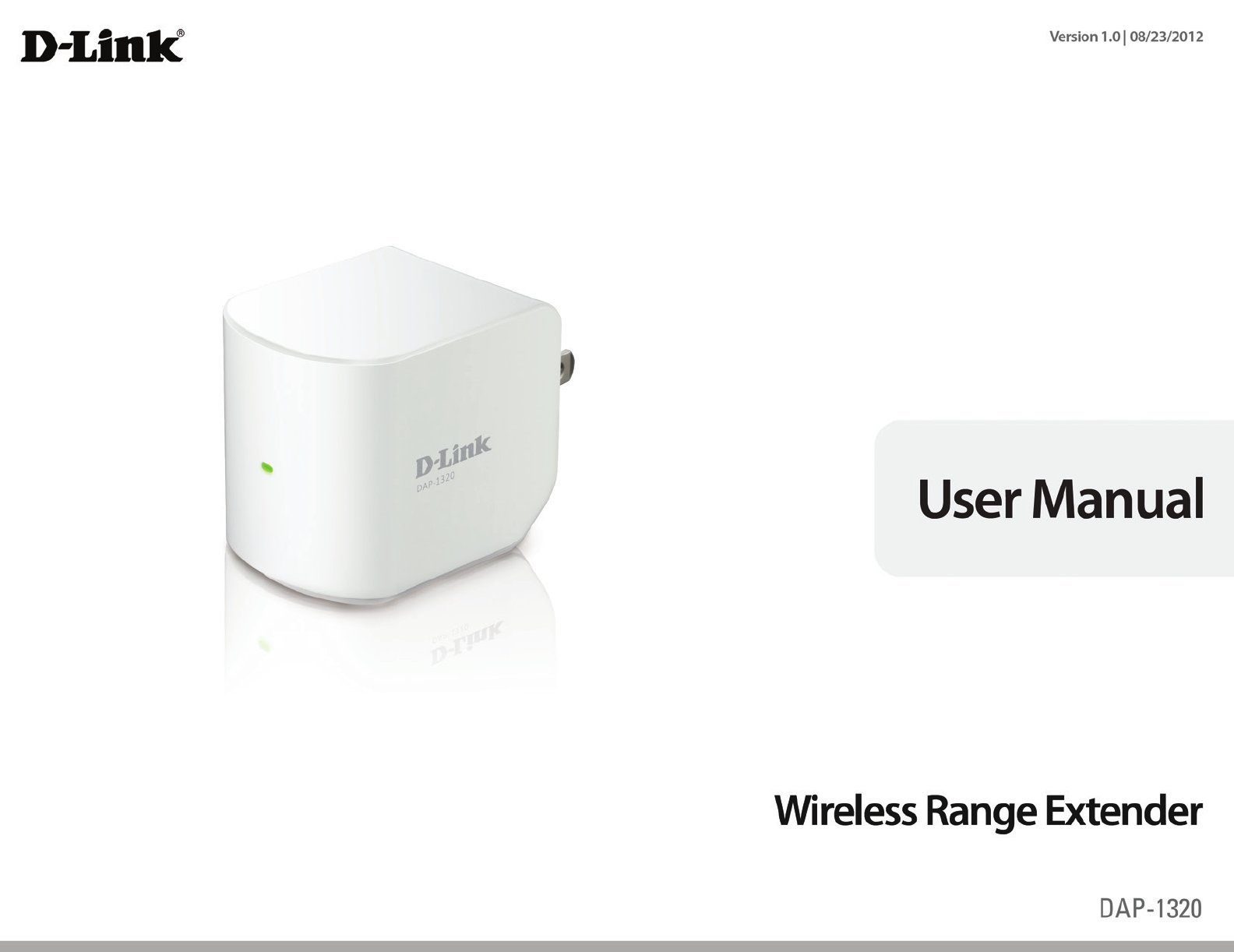
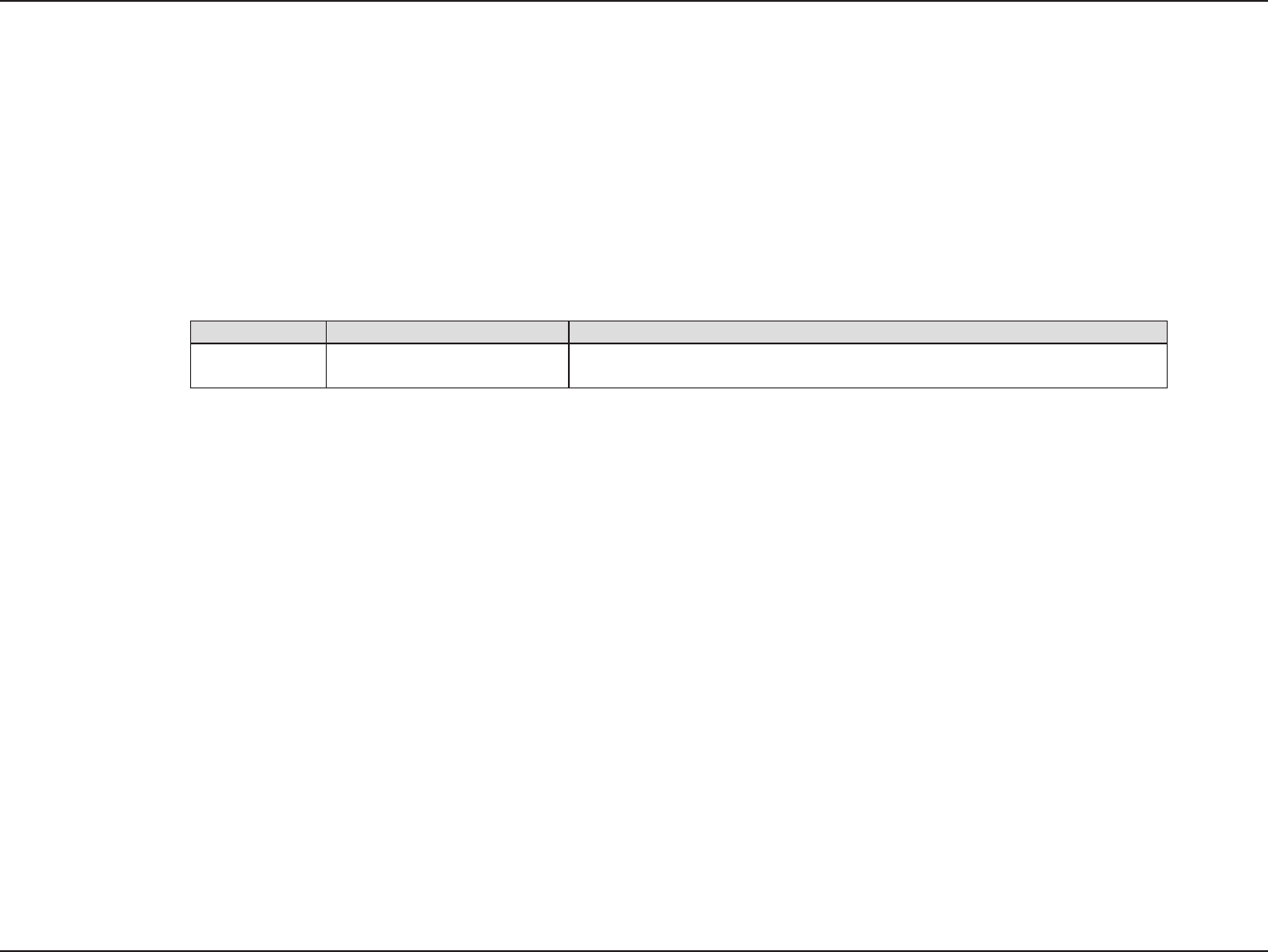
iD-Link DAP-1320 User Manual
D-Link reserves the right to revise this publication and to make changes in the content hereof without obligation to notify any
person or organization of such revisions or changes.
Manual Revisions
Trademarks
D-Link and the D-Link logo are trademarks or registered trademarks of D-Link Corporation or its subsidiaries in the United
States or other countries. All other company or product names mentioned herein are trademarks or registered trademarks of
their respective companies.
Copyright © 2012 by D-Link Systems, Inc.
All rights reserved. This publication may not be reproduced, in whole or in part, without prior expressed written permission
from D-Link Systems, Inc.
Revision Date Description
1.0 August 23, 2012 • Initial release for Revision A1
Preface

iiD-Link DAP-1320 User Manual
Table of Contents
Preface ................................................................................. i
Manual Revisions ........................................................................... i
Trademarks ...................................................................................... i
Product Overview .............................................................. 1
Package Contents ......................................................................... 1
System Requirements ................................................................. 2
Wireless Installation Considerations ...................................... 3
Introduction ................................................................................... 4
Features ............................................................................................ 5
LED ............................................................................................. 6
Installation ......................................................................... 7
Quick Setup Wizard ............................................................13
Setup ...............................................................................................16
Wi-Fi Setup ............................................................................16
Extended Wi-Fi Setup ........................................................18
Wireless Security .........................................................................19
What is WEP? ........................................................................19
Congure WEP .............................................................................20
Congure WPA/WPA2 Personal .............................................21
Maintenance ................................................................................22
Admin .....................................................................................22
System ....................................................................................23
Language Pack .....................................................................24
Firmware ................................................................................24
Time .........................................................................................25
Status ..............................................................................................26
Device Info ............................................................................26
Logs .........................................................................................27
Statistics .................................................................................28
IPv6 ..........................................................................................29
Connect a Wireless Client to your Router ......................30
WPS Button ...................................................................................30
Windows® 7 ...................................................................................32
WPA/WPA2 ............................................................................32
Note: You can nd the SSID and password on the
conguration card. ............................................................33
Windows Vista® ............................................................................35
WPA/WPA2 ............................................................................36
WPS/WCN 2.0 .......................................................................38
Windows® XP ................................................................................39
WPA/WPA2 ............................................................................40
Troubleshooting ..............................................................42
Wireless Basics .................................................................44
What is Wireless? .........................................................................45
Tips ...................................................................................................47
Networking Basics ...........................................................48
Statically Assign an IP address ...............................................49
Table of Contents

iiiD-Link DAP-1320 User Manual
Table of Contents
Technical Specications ..................................................50
Contacting Technical Support ........................................51
Warranty ...........................................................................52
Registration .....................................................................59

1D-Link DAP-1320 User Manual
Section 1 - Product Overview
Product Overview
Package Contents
If any of the above items are missing, please contact your reseller.
DAP-1320 Wireless Range Extender
Wi-Fi Conguration Card
Quick Install Guide
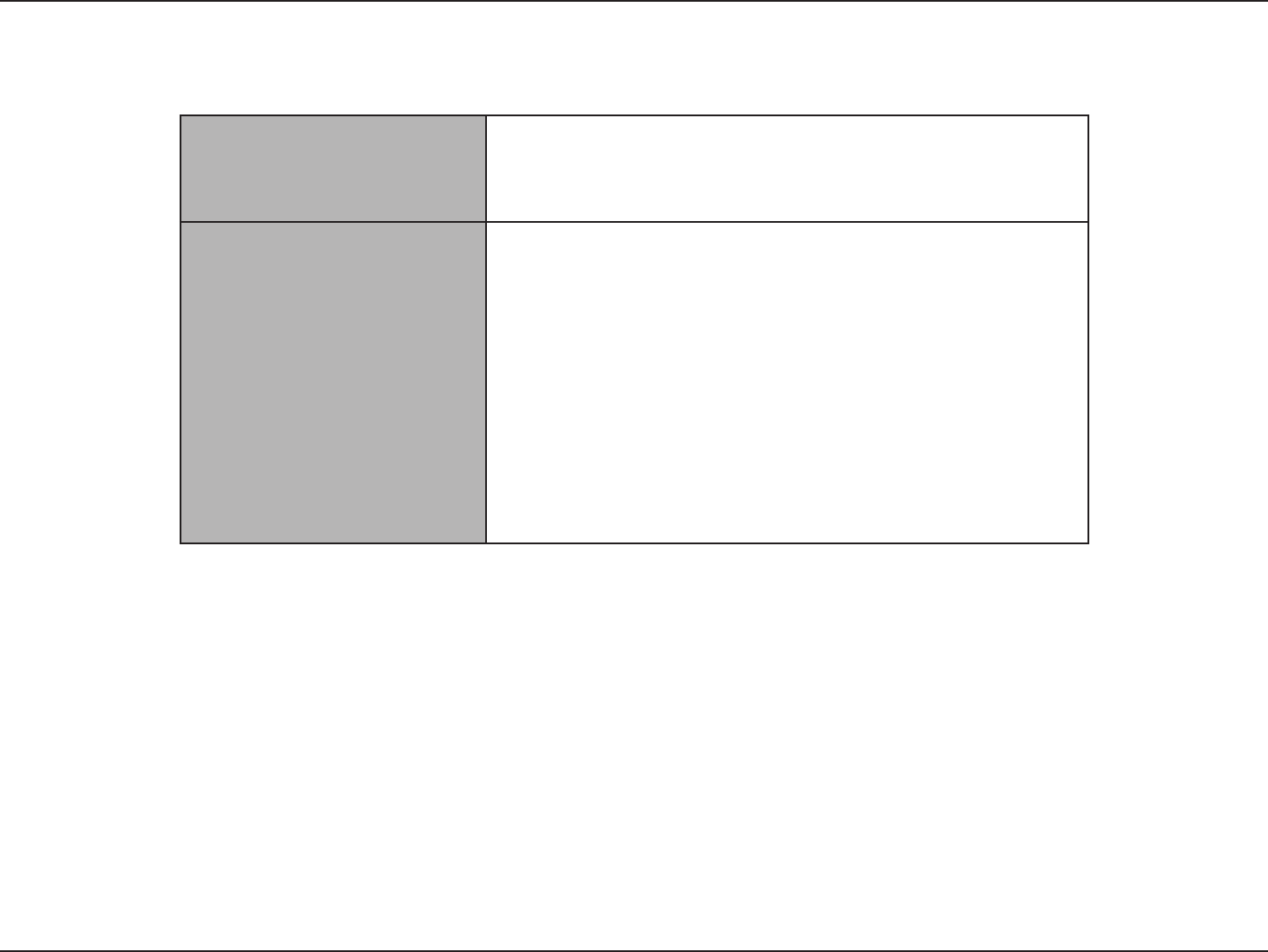
2D-Link DAP-1320 User Manual
Section 1 - Product Overview
Network Requirements • IEEE 802.11n or 802.11g wireless clients
• IEEE 802.11n or 802.11g wireless router or access point
Web-based Conguration
Utility Requirements
Computer with the following:
• Windows®, Macintosh, or Linux-based operating system
Browser Requirements:
• Internet Explorer 6 or higher
• Safari 4 or higher
• Mozilla Firefox
• Google Chrome
Windows® Users: Make sure you have the latest version of Java
installed. Visit www.java.com to download the latest version.
System Requirements

3D-Link DAP-1320 User Manual
Section 2 - Installation
Wireless Installation Considerations
The D-Link wireless device lets you access your network using a wireless connection from virtually anywhere within the
operating range of your wireless network. Keep in mind, however, that the number, thickness and location of walls, ceilings,
or other objects that the wireless signals must pass through, may limit the range. Typical ranges vary depending on the types
of materials and background RF (radio frequency) noise in your home or business. The key to maximizing wireless range is to
follow these basic guidelines:
1. Keep the number of walls and ceilings between the D-Link device and other network devices to a minimum -
each wall or ceiling can reduce your adapter’s range from 3-90 feet (1-30 meters.) Position your devices so that
the number of walls or ceilings is minimized.
2. Be aware of the direct line between network devices. A wall that is 1.5 feet thick (.5 meters), at a 45-degree angle
appears to be almost 3 feet (1 meter) thick. At a 2-degree angle it looks over 42 feet (14 meters) thick! Position
devices so that the signal will travel straight through a wall or ceiling (instead of at an angle) for better reception.
3. Building Materials make a dierence. A solid metal door or aluminum studs may have a negative eect on range.
Try to position access points, wireless routers, and computers so that the signal passes through drywall or open
doorways. Materials and objects such as glass, steel, metal, walls with insulation, water (sh tanks), mirrors, le
cabinets, brick, and concrete will degrade your wireless signal.
4. Keep your product away (at least 3-6 feet or 1-2 meters) from electrical devices or appliances that generate RF
noise.
5. If you are using 2.4GHz cordless phones or X-10 (wireless products such as ceiling fans, lights, and home security
systems), your wireless connection may degrade dramatically or drop completely. Make sure your 2.4GHz phone
base is as far away from your wireless devices as possible. The base transmits a signal even if the phone in not
in use.
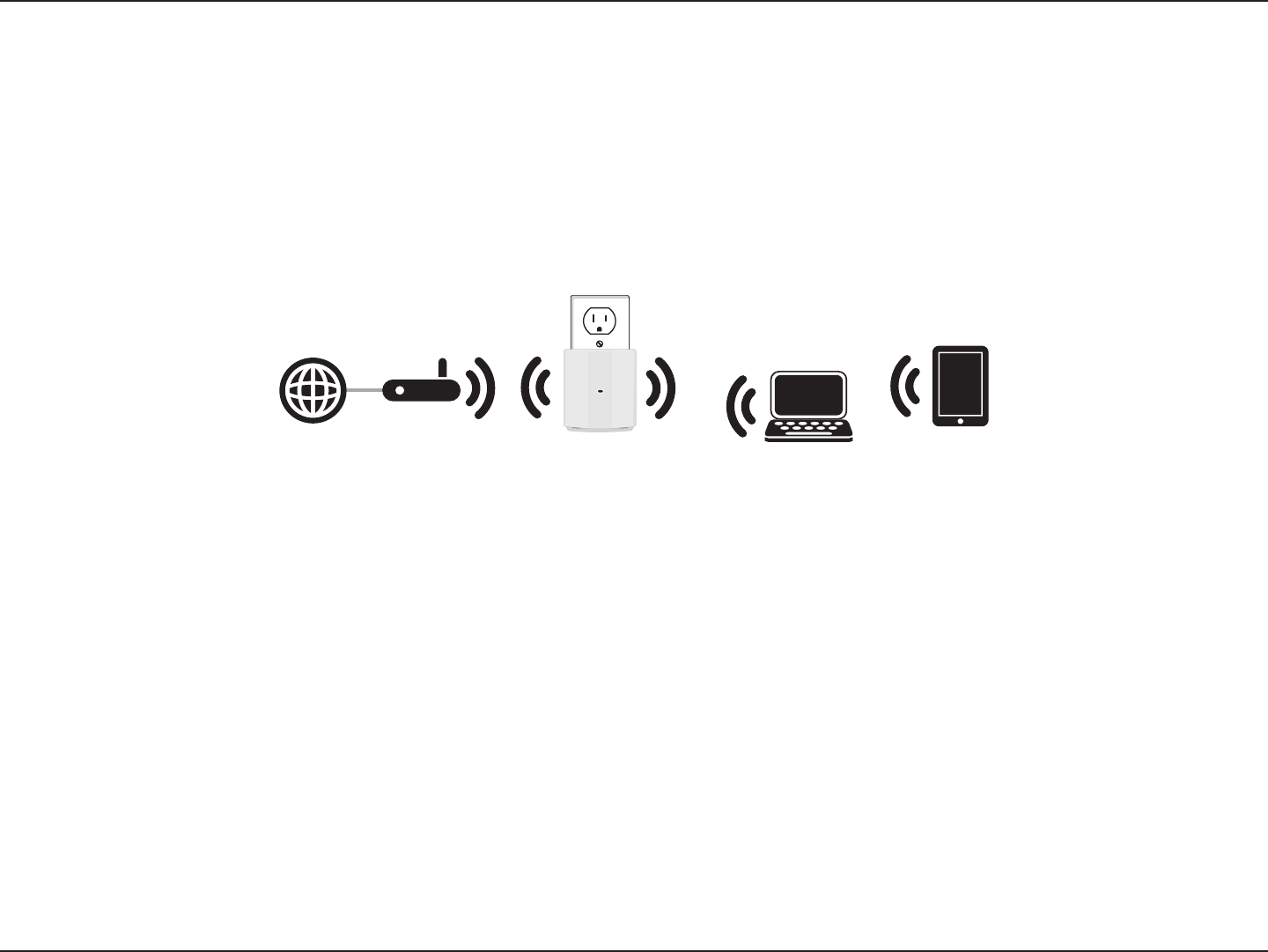
4D-Link DAP-1320 User Manual
Section 1 - Product Overview
Introduction
The Wireless Range Extender (DAP-1320) enables you to extend your existing wireless network coverage by placing the
Wireless Range Extender in between your router and the wireless client devices. This is great for extending wireless coverage
to basements, home oces or bedrooms that might be distant from your wireless router. The DAP-1320 increases the range
of your wireless network by extending the wireless coverage of an existing wireless network.
Note: Place the DAP-1320 within equal distance of your existing network/router and wireless clients.

5D-Link DAP-1320 User Manual
Section 1 - Product Overview
• Faster Wireless Networking - The DAP-1320 provides up to 300Mbps* wireless connection with other 802.11n
wireless clients. This capability allows users to participate in real-time activities online, such as video streaming,
online gaming, and real-time audio.
• Extend Internet access for wireless devices - Allows you to extend your internet access
throughout your home with devices such as laptops, Smartphones, tablets and more.
• IEEE 802.11n and 802.11g Compliant - The DAP-1320 is still fully compatible with the IEEE 802.11g standards,
so it can connect with existing 802.11g, USB, and Cardbus adapters.
• User-friendly Setup Wizard - Through its easy-to-use Web-based user interface, the DAP-1320 lets you control
what information is accessible to those on the wireless network, whether from the Internet or from your company’s
server. Congure your router to your specic settings within minutes.
* Maximum wireless signal rate derived from IEEE Standard 802.11g and 802.11n specications. Actual data throughput will vary. Network conditions and environmental factors,
including volume of network trac, building materials and construction, and network overhead, lower actual data throughput rate. Environmental conditions will adversely
aect wireless signal range.
Features
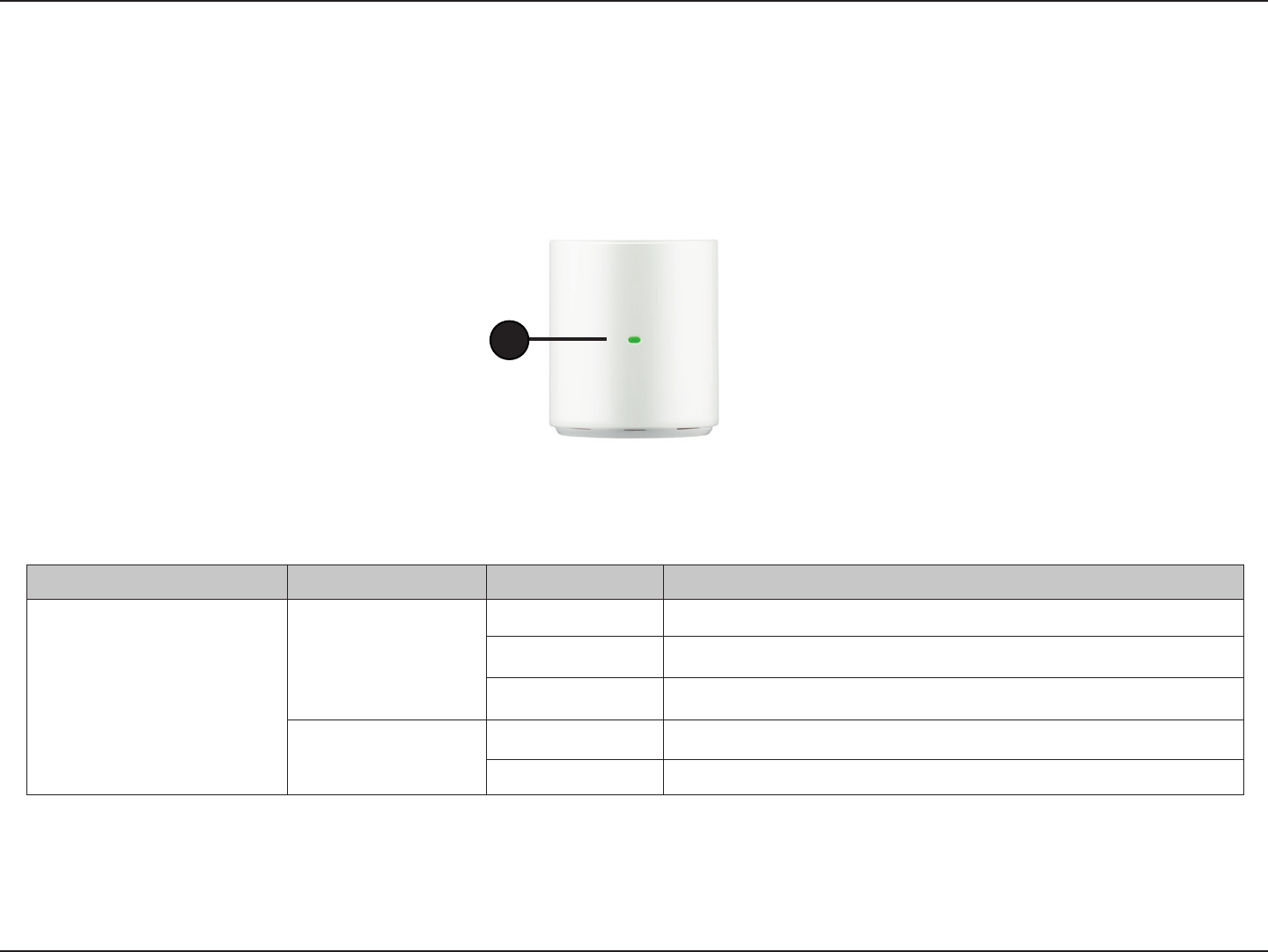
6D-Link DAP-1320 User Manual
Section 1 - Product Overview
Hardware Overview
LED
LED Indicator Color Status Description
Power/Status
Green
Solid Green The device is connected within the existing network/Router.
Blinking Green The device is processing a connection
Light o The device is o
Amber
Solid Amber During Power ON & while the device is warming up
Light o The device is powered o
1

7D-Link DAP-1320 User Manual
Section 1 - Product Overview
Installation
Please congure the DAP-1320 with a computer wireless to the AP using the conguration card information connected. The
next few pages will further explain.
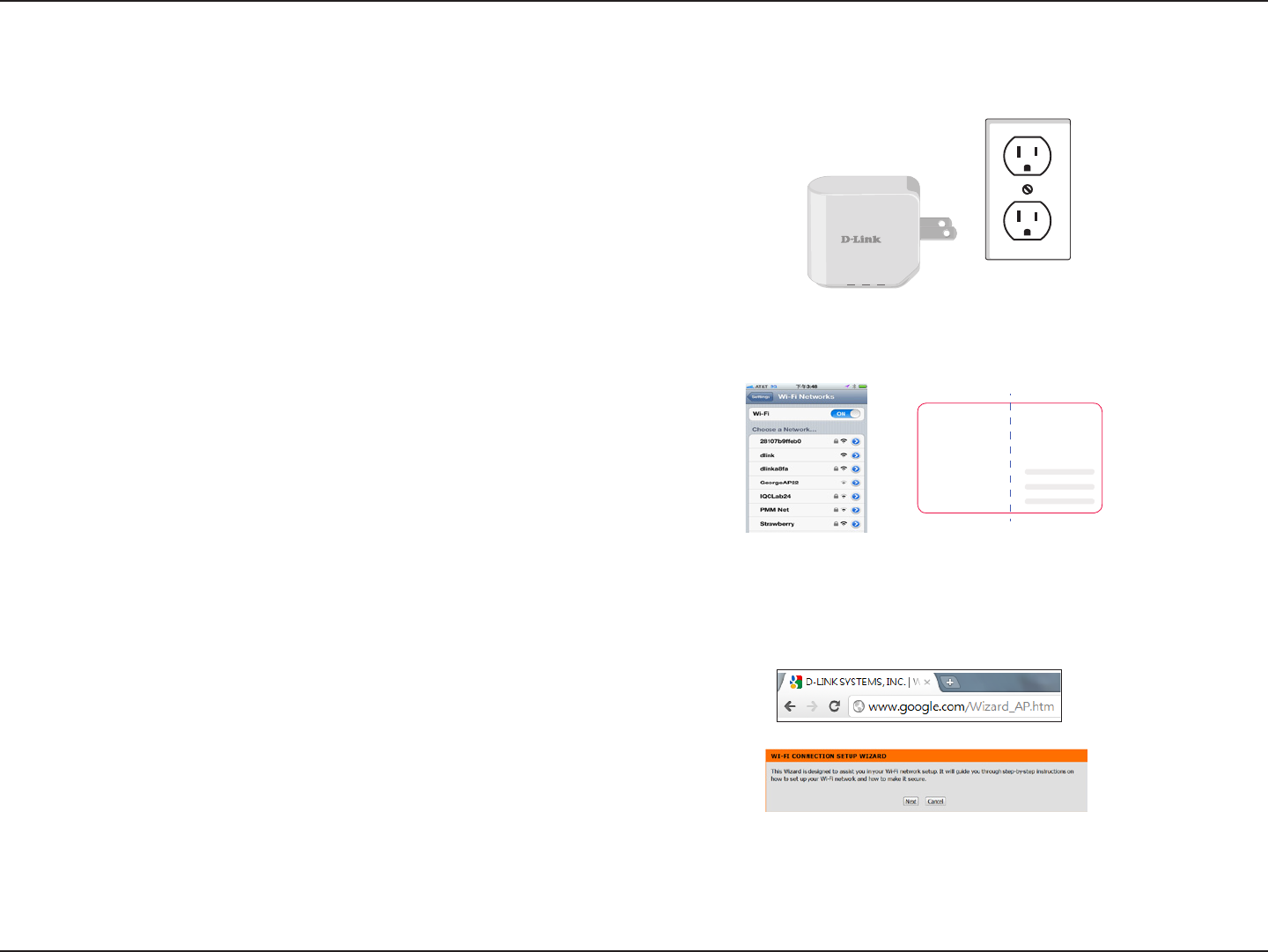
8D-Link DAP-1320 User Manual
Section 2 - Installation
1. Plug the DAP-1320 into a wall outlet and verify that the power LED
has turned red to a blinking green.
2. From your laptop or mobile device go to your Wireless Utility to
display the available wireless networks and select the network that
is displayed on your companion card (ex: dlink-a8fa). Then, enter
the Wi-Fi password included in your card (akbdj1936).
3. Open a web browse and type http://dlinkap.local. First time users
will automatically be directed to the pre-wizard. Please follow the
on-screen instructions to complete the manual setup.
If this is your second time type http://dlinkap in the address bar.
90mm
54mm
Web browser link:
http://dlinkrouter or
http:// 192.168.0.1
Default conguration
Username: “Admin”
Password: ““ (leave the eld blank)
Wi- Fi Name (SSID) :
dlinka8fa
Wi-Fi Password :
akbdj19368
Web browser link:
http://dlinkrouter or
http:// 192.168.0.1
Your conguration
Username: Admin
Password:
Wi- Fi Name (SSID) :
Wi-Fi Password :
D-Link DIR-505 Mobile Companion Wi-Fi Conguration Note
DAP-1320
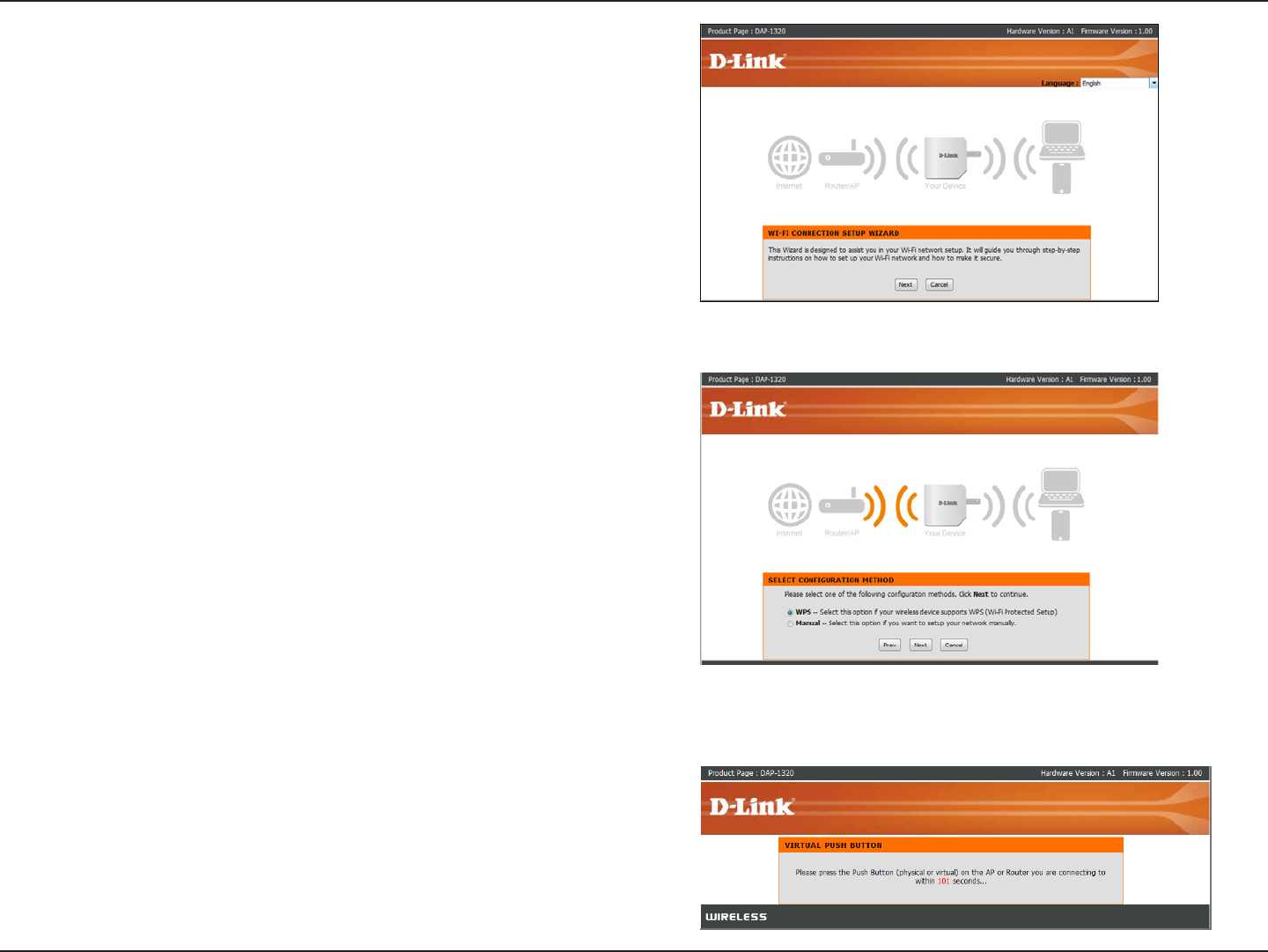
9D-Link DAP-1320 User Manual
Section 3 - Conguration
Select WPS as the conguration method only if your wireless
device supports Wi-Fi Protected Setup (WPS). For Manual setup,
skip to page 10.
Click Next to continue.
To start the Setup Wizard click Next.
Press down the Push Button on the Wireless device you are adding
to your wireless network.

10D-Link DAP-1320 User Manual
Section 3 - Conguration
Select Manual as the configuration method to set up your
network manually.
Click Next to continue.
Please wait while your device scans for available Wi-Fi networks.
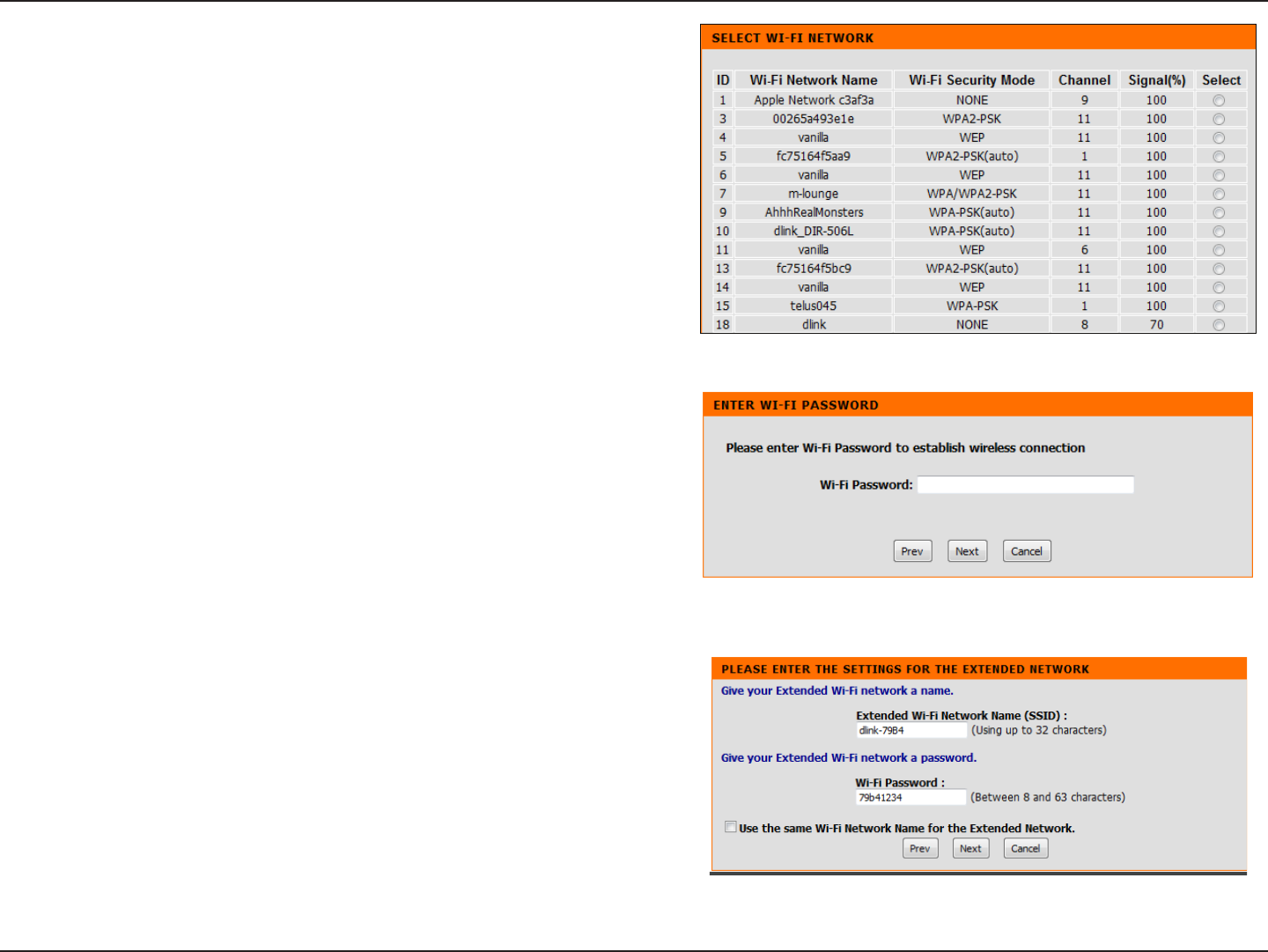
11D-Link DAP-1320 User Manual
Section 3 - Conguration
Select the network you would like your device to connect to
and click Connect to continue.
You can choose to change the SSID and the password for the
DAP-1320 or you can enter the information found in your
conguration card. Click Next to continue and nish the setup
process.
Enter the existing Wi-Fi Password for the router you are using to
connect and click Next.
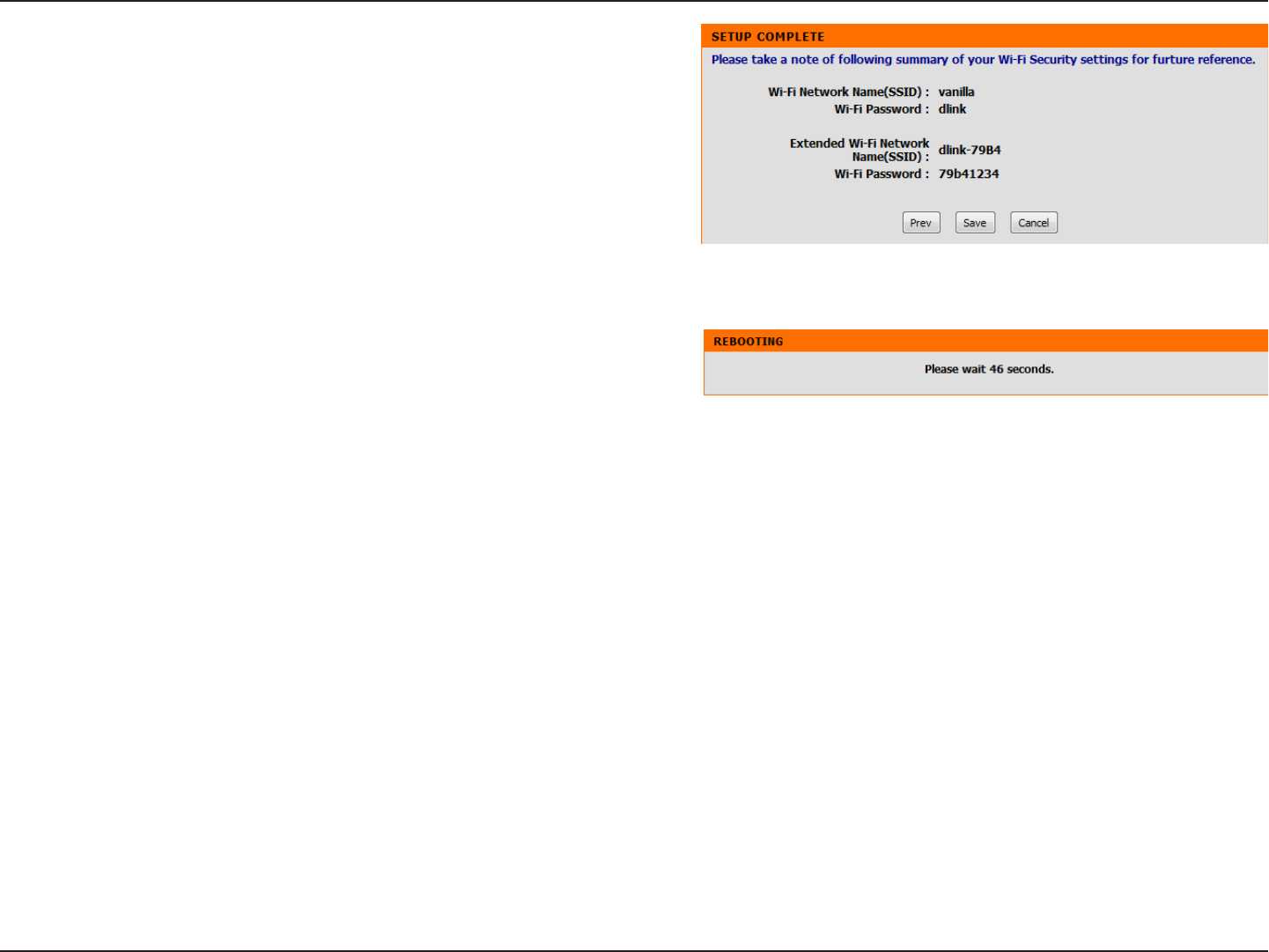
12D-Link DAP-1320 User Manual
Section 3 - Conguration
The setup is now complete. Please keep Save to nish.
Please wait while the system reboots.
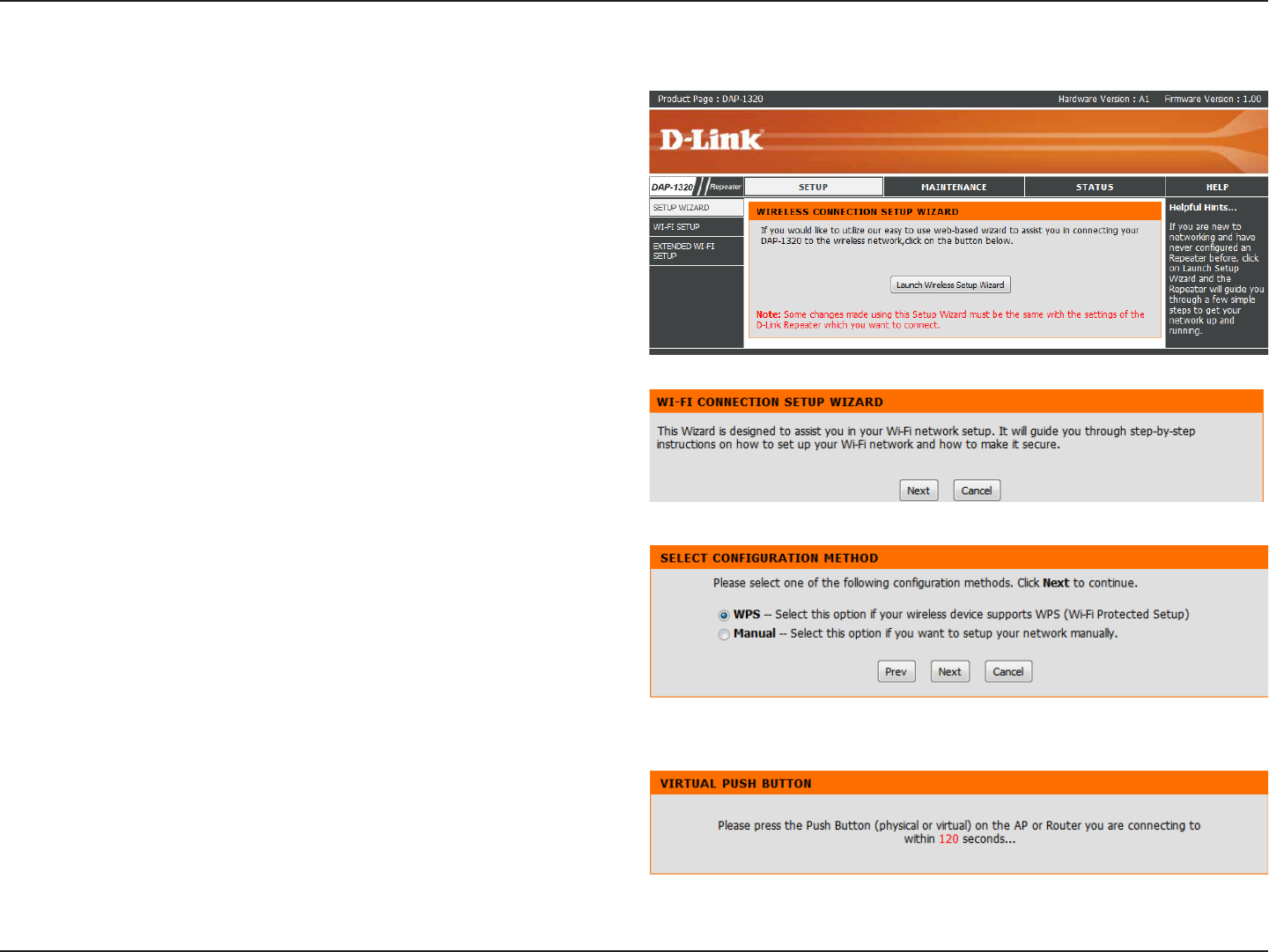
13D-Link DAP-1320 User Manual
Section 3 - Conguration
Quick Setup Wizard
Click Launch Wireless Setup Wizard to begin the Setup
Wizard.
To start the Setup Wizard click Next.
Select WPS as the conguration method only if your wireless
device supports Wi-Fi Protected Setup (WPS).
Click Next to continue.
Press down the Push Button on the Wireless device you are
adding to your wireless network.
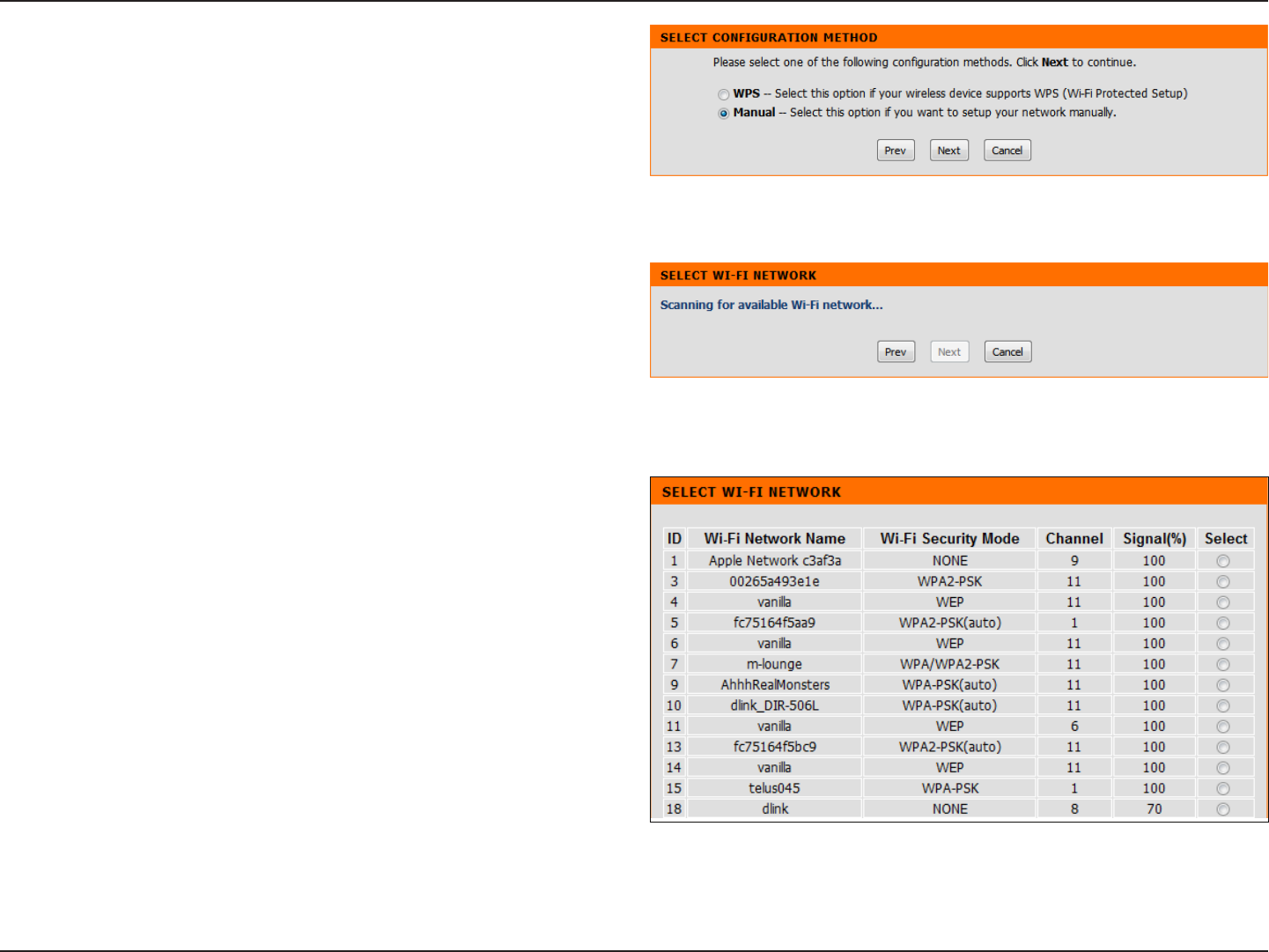
14D-Link DAP-1320 User Manual
Section 3 - Conguration
Select Manual as the conguration method to set up your
network manually.
Click Next to continue.
Select the network you would like your device to connect
to and click Connect to continue.
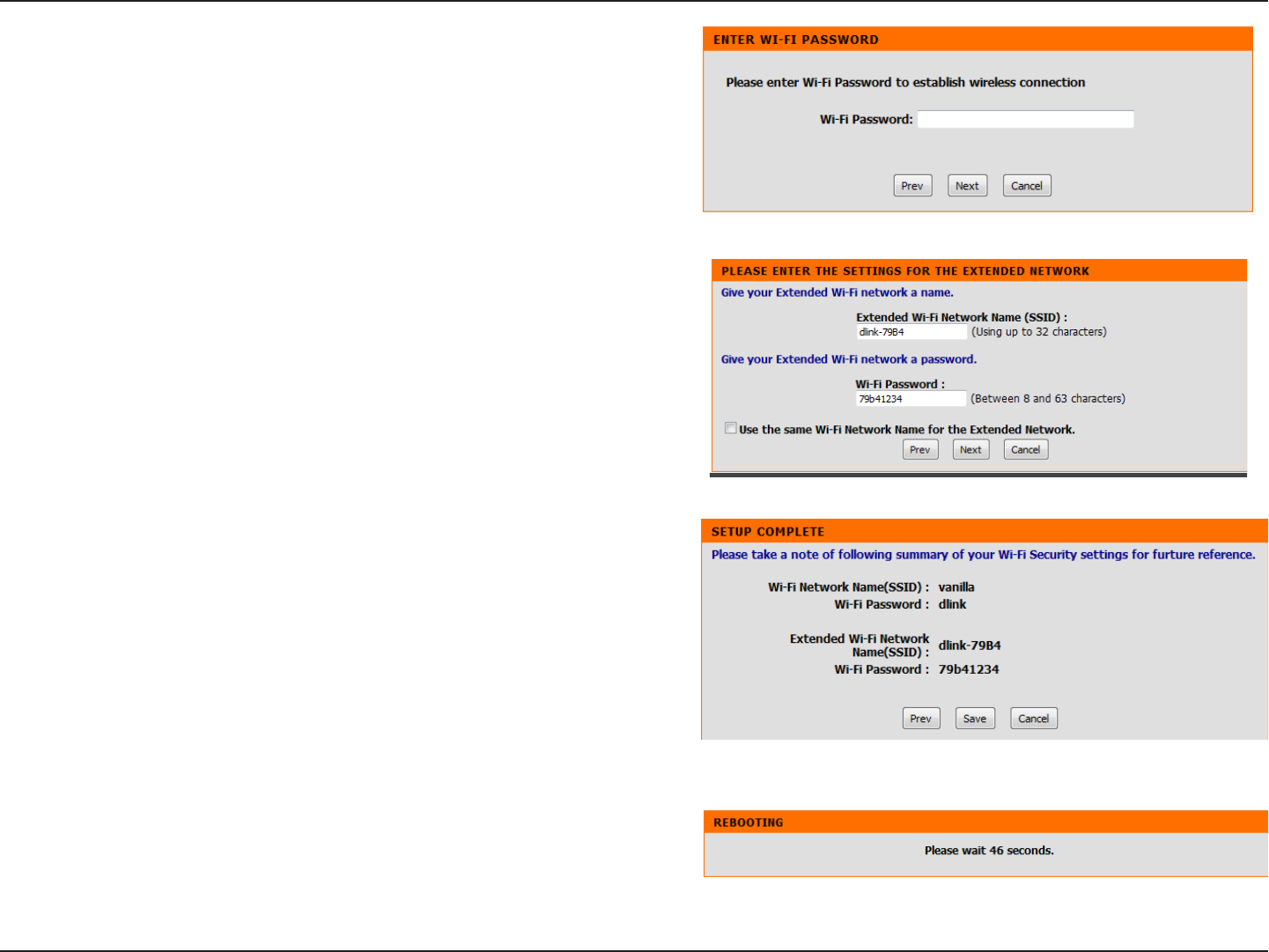
15D-Link DAP-1320 User Manual
Section 3 - Conguration
Enter the existing Wi-Fi Password for the router you are using to
connect and click Next.
You can choose to change the SSID and the password for the
DAP-1320 or you can enter the information found in your
conguration card. Click Next to continue and nish the setup
process.
The setup is now complete. Please keep Save to nish.
Please wait while the system reboots.
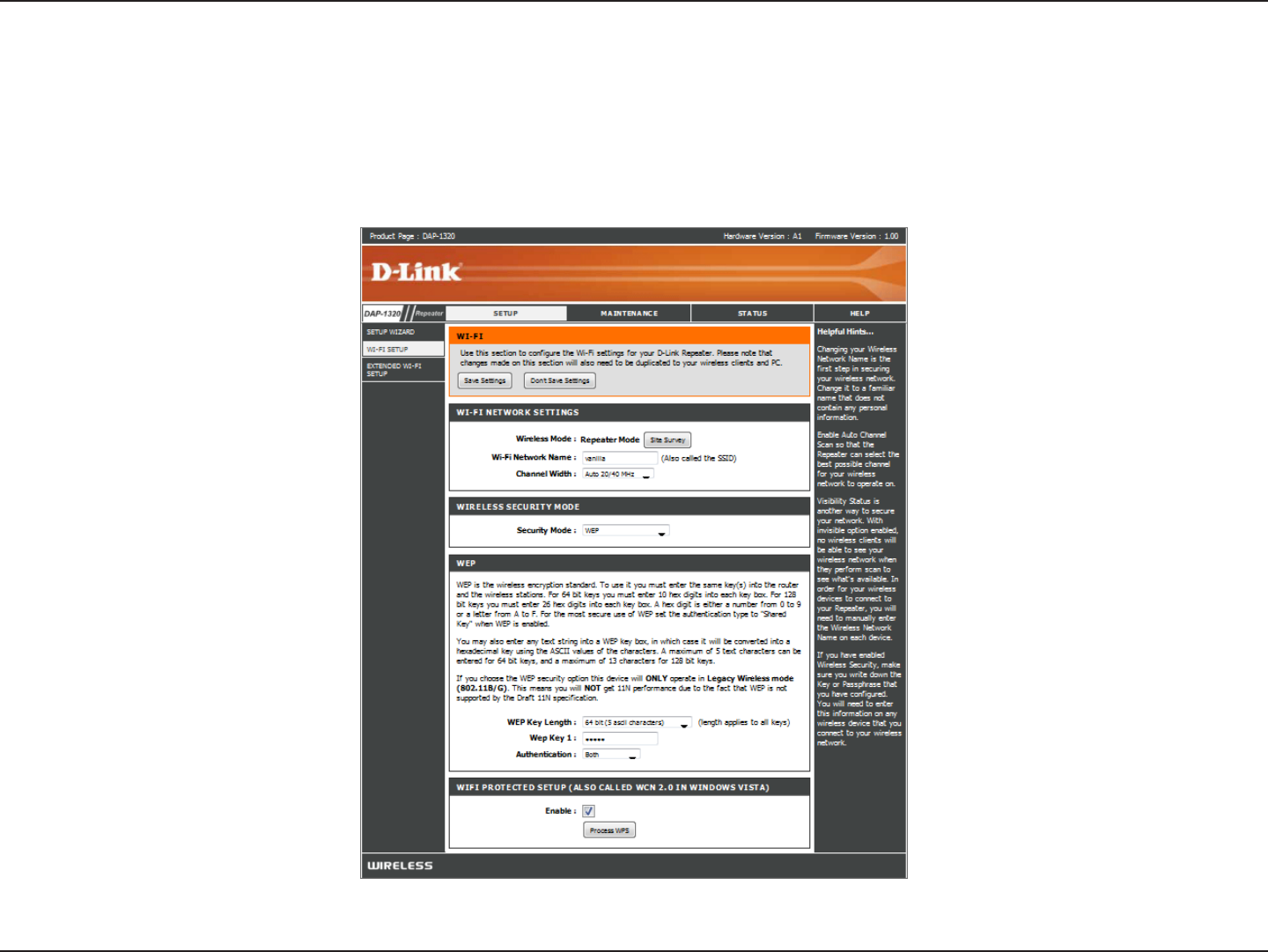
16D-Link DAP-1320 User Manual
Section 3 - Conguration
Setup
Wi-Fi Setup
Use this section to manually congure the wireless settings for your D-Link Repeater.
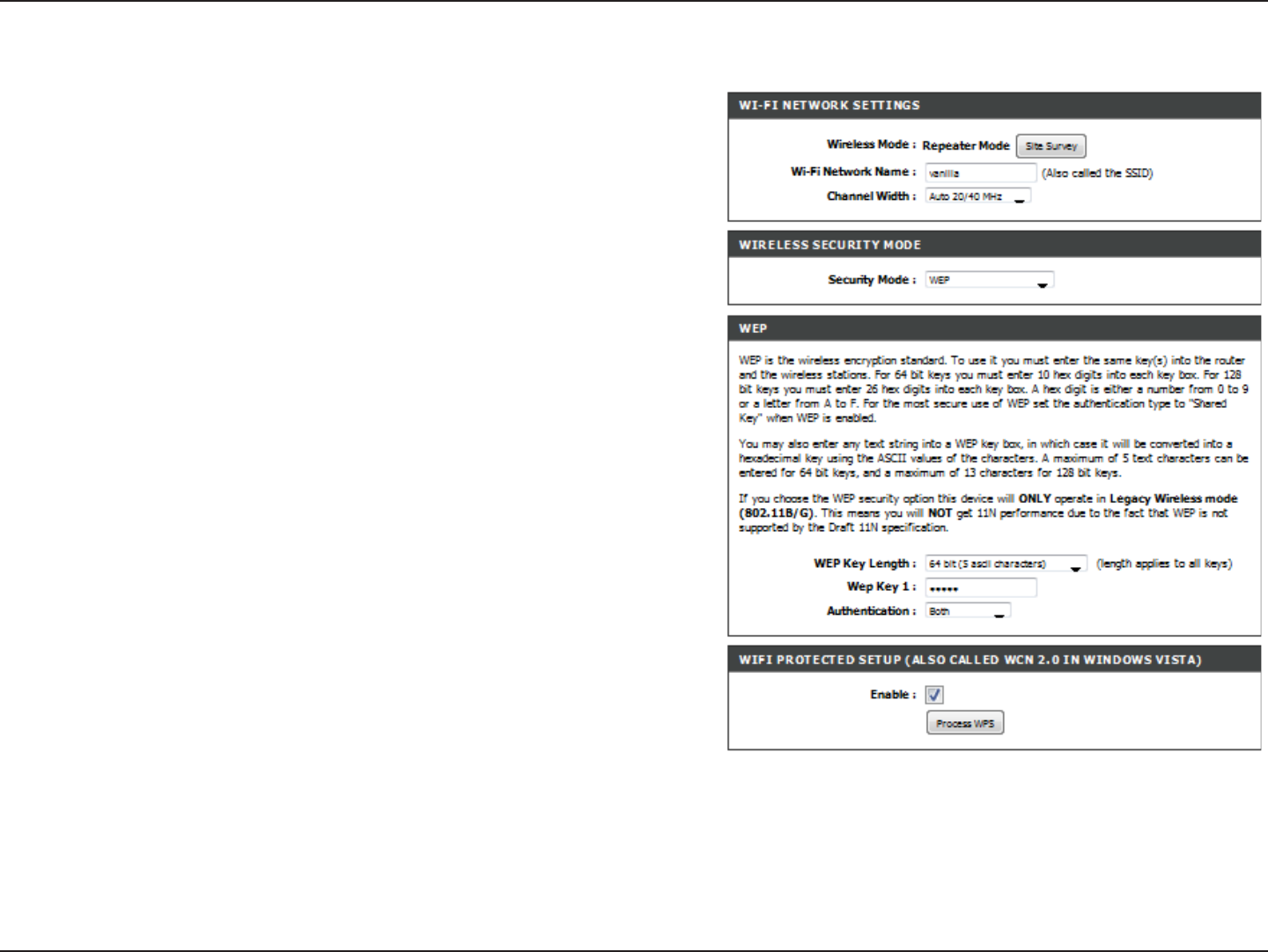
17D-Link DAP-1320 User Manual
Section 3 - Conguration
Wireless Mode:
Site Surveys:
Wireless
Network Name:
Channel Width:
Security Mode:
This will automatically be Repeater Mode.
Scans for available Wi-Fi networks.
When you are browsing for available wireless networks, this is the
name that will appear in the list (unless Visibility Status is set to
Invisible, see below). This name is also referred to as the SSID. For
security purposes, it is highly recommended to change from the
default network name.
Select the appropriate channel width between 20MHz or Auto
20/40MHz from the drop-down menu.
Select WEP or WPA Personal. Refer to page 88.
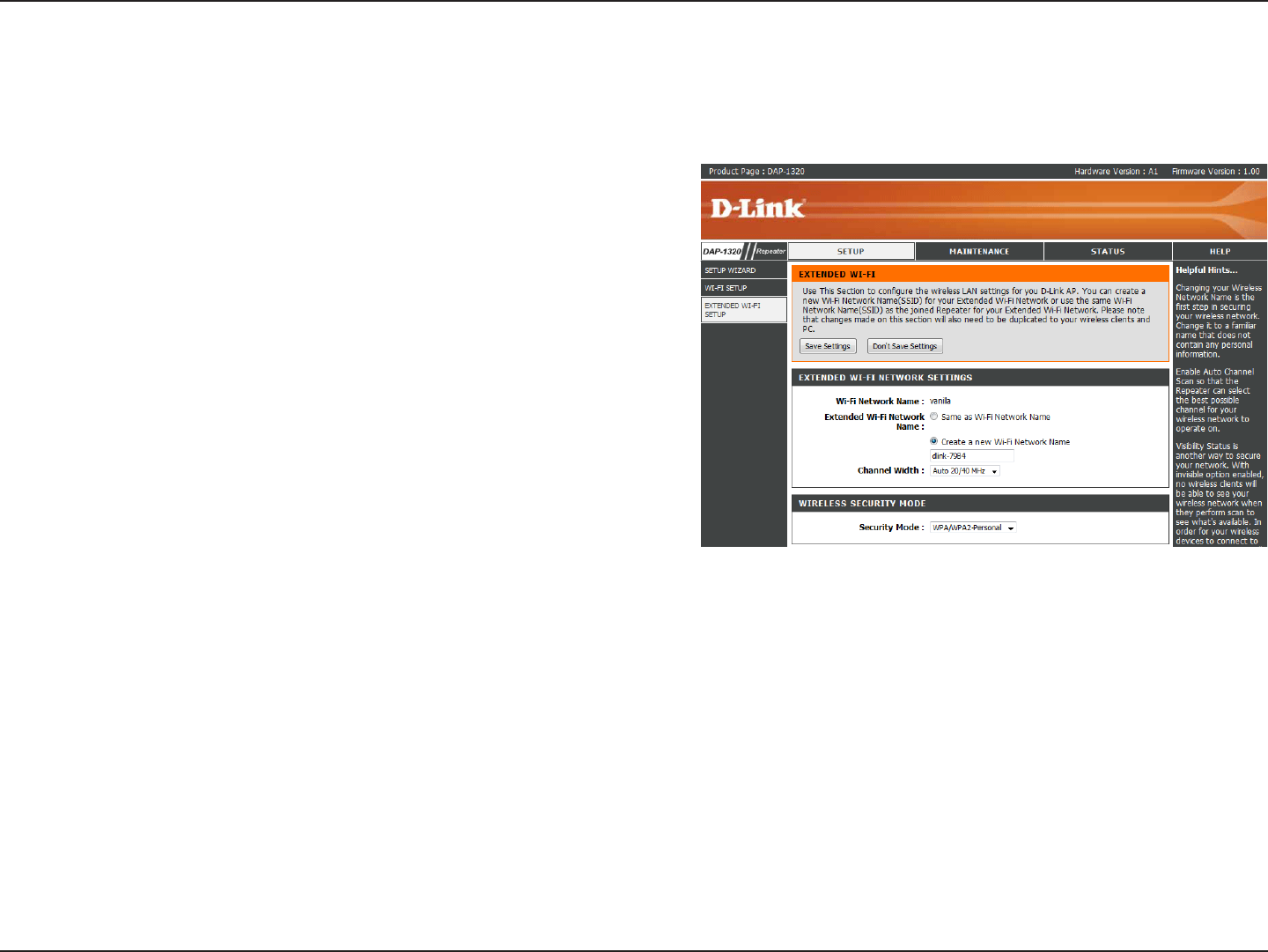
18D-Link DAP-1320 User Manual
Section 3 - Conguration
Extended Wi-Fi Setup
This page allows you to congure the wireless LAN Settings for your D-Link AP. You have the option of creating a new Wi-Fi
Network Name for your DAP-1320 or you may use the same Wi-Fi Network Name as your repeater or router.
Wi-Fi Network
Name:
Extended Wi-Fi
Network Name:
Channel Width:
Displays the current Wi-Fi Network Name you connected
to during conguration.
Select Same as Wi-Fi Network Name or Create a new
Wi-Fi Network Name.
Select the appropriate channel width between 20MHz or
Auto 20/40MHz from the drop-down menu.

19D-Link DAP-1320 User Manual
Section 3 - Conguration
Wireless Security
This section will show you the dierent levels of security you can use to protect your data from intruders. The
DAP-1320 oers the following types of security:
• WPA2 (Wi-Fi Protected Access 2) • WPA2-PSK (Pre-Shared Key)
• WPA (Wi-Fi Protected Access) • WPA-PSK (Pre-Shared Key)
• WEP (Wired Equivalent Privacy)
What is WEP?
WEP stands for Wired Equivalent Privacy. It is based on the IEEE 802.11 standard and uses the RC4 encryption algorithm. WEP
provides security by encrypting data over your wireless network so that it is protected as it is transmitted from one wireless
device to another.
To gain access to a WEP network, you must know the key. The key is a string of characters that you create. When using WEP,
you must determine the level of encryption. The type of encryption determines the key length. 128-bit encryption requires a
longer key than 64-bit encryption. Keys are dened by entering in a string in HEX (hexadecimal - using characters 0-9, A-F) or
ASCII (American Standard Code for Information Interchange – alphanumeric characters) format. ASCII format is provided so
you can enter a string that is easier to remember. The ASCII string is converted to HEX for use over the network. Four keys can
be dened so that you can change keys easily.
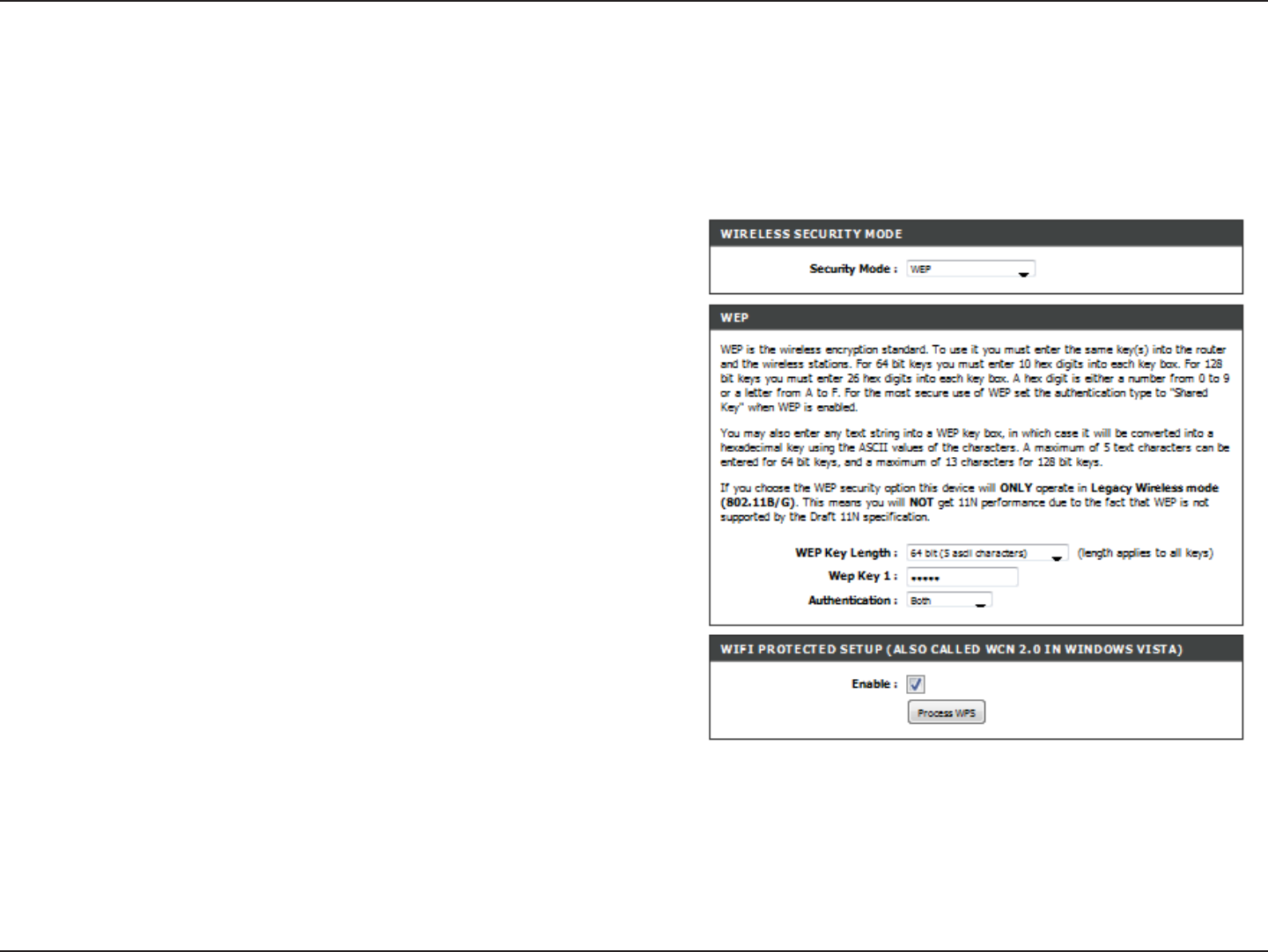
20D-Link DAP-1320 User Manual
Section 3 - Conguration
Congure WEP
It is recommended to enable encryption on your wireless router before your wireless network adapters. Please establish
wireless connectivity before enabling encryption. Your wireless signal may degrade when enabling encryption due to the
added overhead.
1. Log into the web-based conguration by opening a web browser
and entering the IP address of the router (192.168.0.1).
Click on Wireless Setup on the left side.
2. In the Security Mode section, select WEP from the drop-down
menu.
3. In WEP Key Length, select either 64Bit or 128Bit encryption from
the drop-down menu.
5. Next to WEP Key 1, enter a WEP key that you create. Make sure you
enter this key exactly on all your wireless devices. You may enter up
to four dierent keys either using Hex or ASCII. Hex is recommended
(letters A-F and numbers 0-9 are valid). In ASCII all numbers and
letters are valid.
6. Click Save Settings to save your settings. If you are conguring the
router with a wireless adapter, you will lose connectivity until you
enable WEP on your adapter and enter the same WEP key as you did
on the router.

21D-Link DAP-1320 User Manual
Section 3 - Conguration
Congure WPA/WPA2 Personal
It is recommended to enable encryption on your wireless access point before your wireless network adapters. Please establish
wireless connectivity before enabling encryption. Your wireless signal may degrade when enabling encryption due to the
added overhead.
1. Log into the web-based conguration by opening a web browser
and entering the IP address of the access point (192.168.0.50).
Click on Setup and then click Wireless Settings on the left side.
2. Next to Security Mode, select WPA-Personal.
3. Next to Cipher Type, select TKIP, AES, or Auto.
4. Next to Passphrase, enter a key. The key is entered as a passphrase
in ASCII format at both ends of the wireless connection. The
passphrase must be between 8-63 characters.
6. Click Save Settings at the top of the window to save your
settings. If you are conguring the access point with a wireless
adapter, you will lose connectivity until you enable WPA-PSK on
your adapter and enter the same passphrase as you did on the
access point.
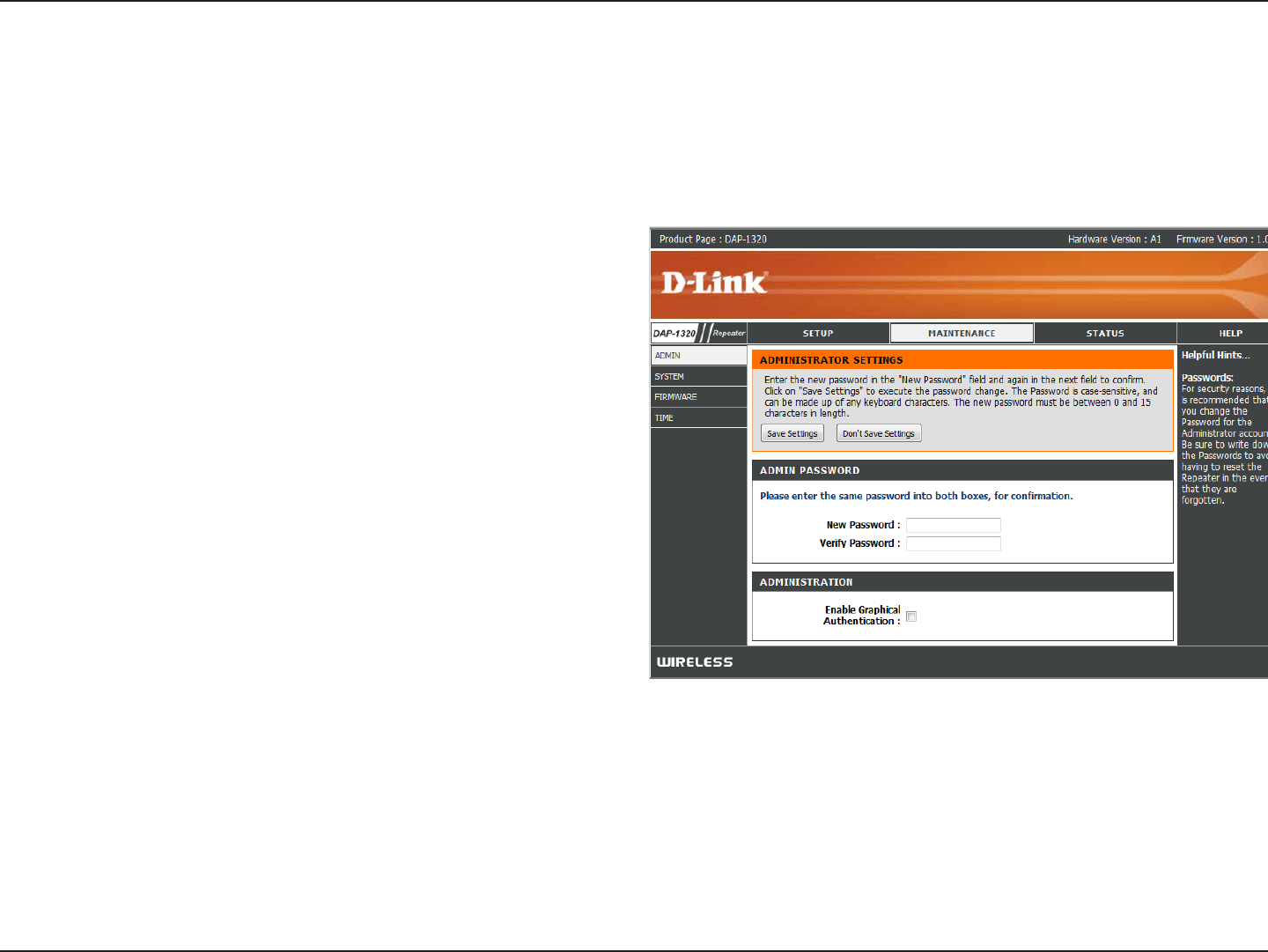
22D-Link DAP-1320 User Manual
Section 3 - Conguration
Password:
Conrm
Password:
Enable
Graphical
Authentication:
Enter a new password for the Administrator Login Name.
The administrator can make changes to the settings.
Enter the same password that you entered in the
previous textbox in order to conrm its accuracy.
Check to enable this feature.
Maintenance
Admin
This page will allow you to change the Administrator password. The administrator password has read/write access.
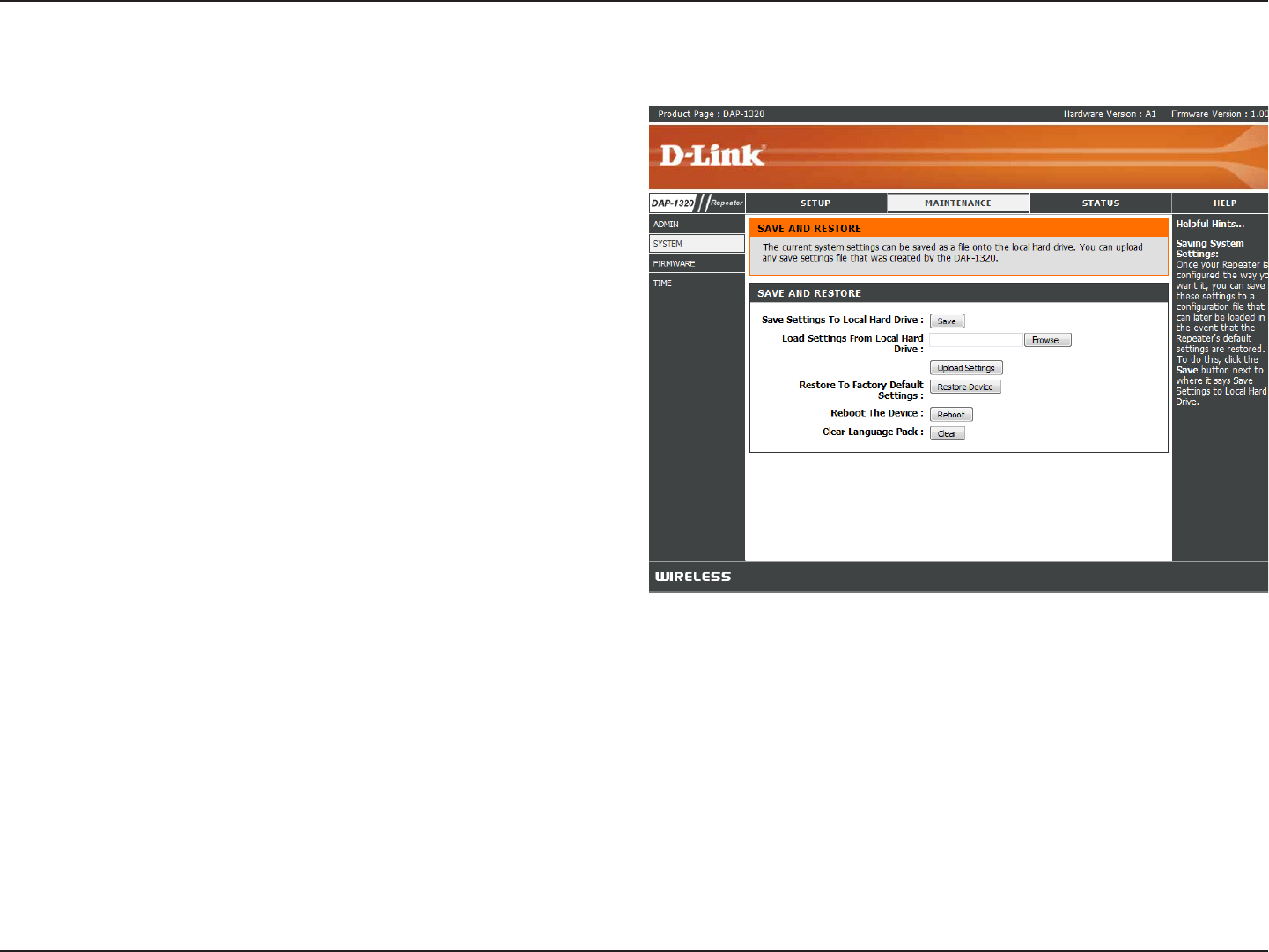
23D-Link DAP-1320 User Manual
Section 3 - Conguration
Save to Local
Hard Drive:
Upload from
Local Hard Drive:
Restore to
Factory Default:
Reboot the
Device:
Use this option to save the current repeater conguration
settings to a le on the hard disk of the computer you
are using. Click the Save button. You will then see a le
dialog where you can select a location and le name for
the settings.
Use this option to load previously saved access point
conguration settings. Click Browse to nd a previously
saved conguration le. Then, click the Upload Settings
button to transfer those settings to the repeater.
This option will restore all conguration settings back
to the settings that were in eect at the time the access
point was shipped from the factory. Any settings that
have not been saved will be lost, including any rules that
you have created. If you want to save the current access
point conguration settings, use the Save button above.
Note: Restoring the factory default settings will not reset
the Wi-Fi Protected Status to Not Congured.
Click to reboot the repeater.
System
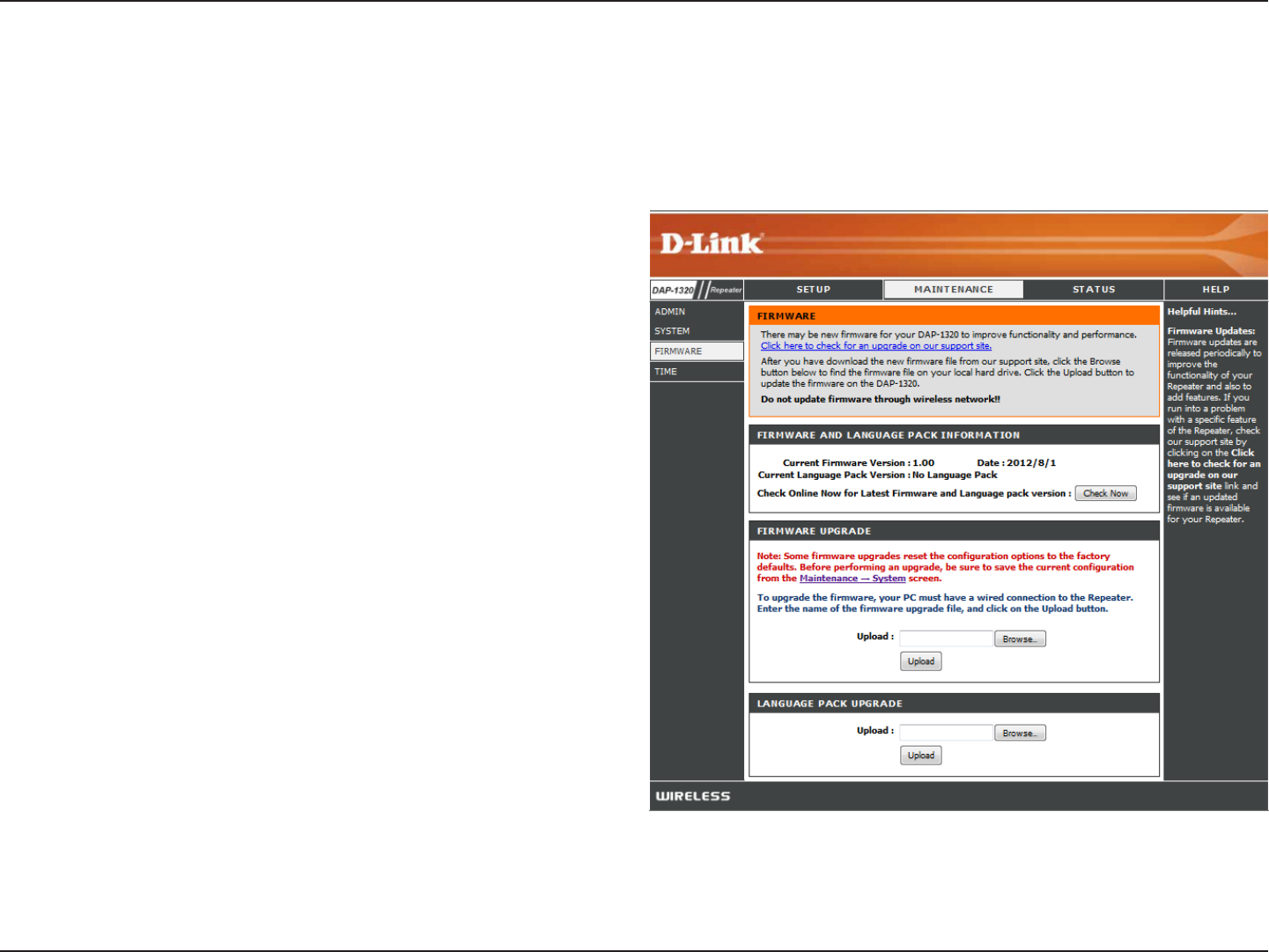
24D-Link DAP-1320 User Manual
Section 3 - Conguration
Firmware
Upgrade:
Browse:
Upload:
Click on Check Now to nd out if there is an updated
rmware; if so, download the new rmware to your
hard drive.
After you have downloaded the new rmware, click
Browse to locate the rmware update on your hard
drive. Click Upload to complete the rmware upgrade.
Once you have a rmware update on your computer,
use this option to browse for the le and then upload
the information into the access point.
Firmware
You can upgrade the rmware of the repeater here. Make sure the rmware you want to use is on the local hard drive of the
computer. Click on Browse to locate the rmware le to be used for the update. Please check the D-Link support website for
rmware updates at http://support.dlink.com. You can download rmware upgrades to your hard drive from this site.
After you have downloaded the new language pack,
click Browse to locate the language pack le on your
hard drive. Click Upload to complete the language
pack upgrade.
Language Pack
You can change the language of the web UI by uploading
available language packs.
Browse:
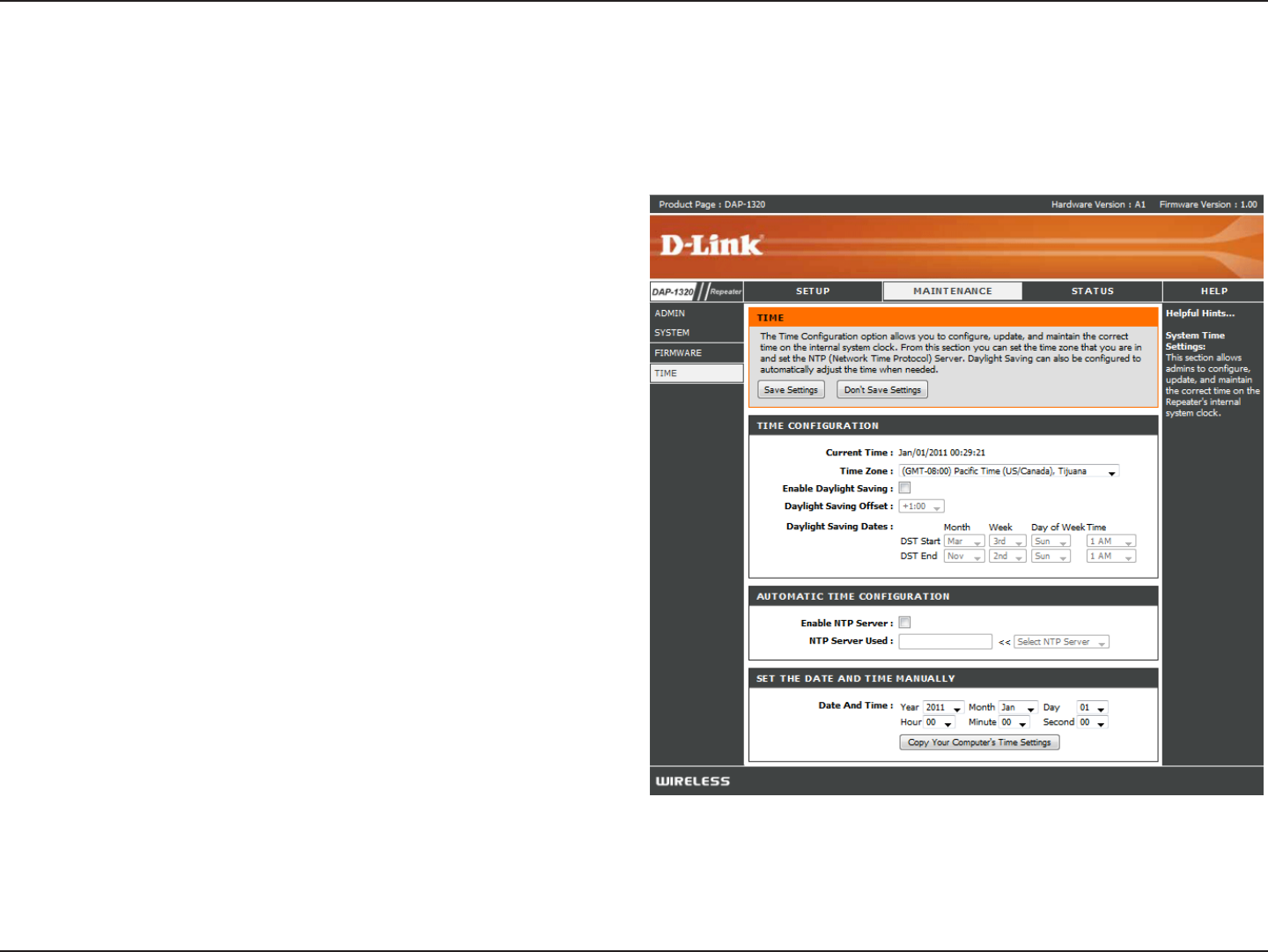
25D-Link DAP-1320 User Manual
Section 3 - Conguration
Time Zone:
Daylight
Saving:
Enable NTP
Server:
NTP Server
Used:
Date and Time:
Select the Time Zone from the drop-down menu.
To select Daylight Saving time manually, click the Enable
Daylight Saving check box. Next use the drop-down
menu to select a Daylight Saving Oset and then enter a
start date and an end date for daylight saving time.
NTP is short for Network Time Protocol. NTP synchronizes
computer clock times in a network of computers. Check
this box to use a NTP server. This will only connect to a
server on the Internet, not a local server.
Enter the NTP server or select one from the drop-down
menu.
To manually input the time, enter the values in these
elds for the Year, Month, Day, Hour, Minute, and Second
and then click Save Settings. You can also click the Copy
Your Computer’s Time Settings button at the bottom
of the screen.
Time
The Time Conguration option allows you to congure, update, and maintain the correct time on the internal system clock.
From this section you can set the time zone that you are in. Daylight Saving can also be congured to automatically adjust the
time when needed.
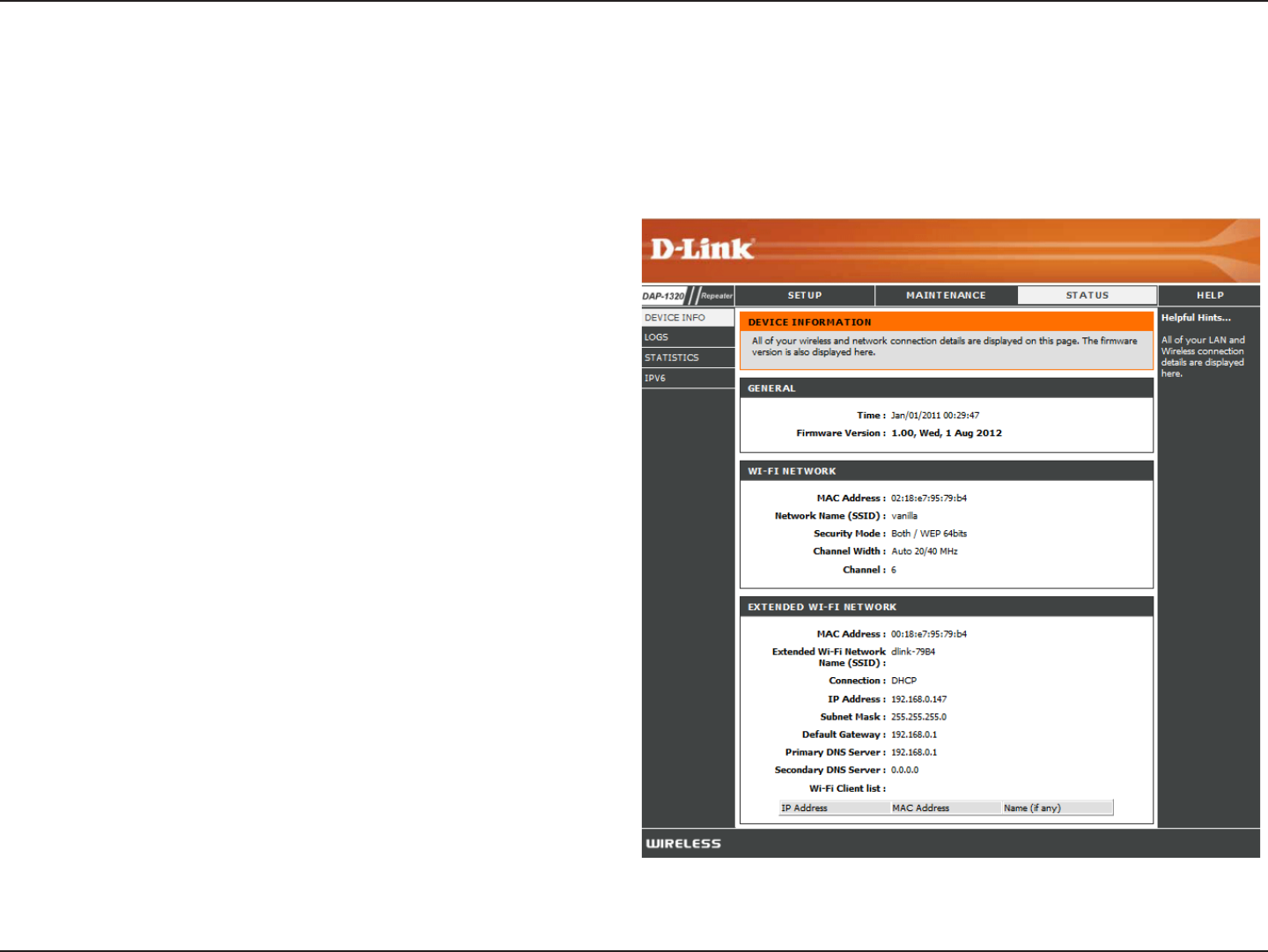
26D-Link DAP-1320 User Manual
Section 3 - Conguration
General:
LAN:
Wireless LAN:
Displays the access point’s time and firmware
version.
Displays the MAC address and the private (local) IP
settings for the access point.
Displays the wireless MAC address and your
wireless settings such as SSID and Channel.
Status
Device Info
This page displays the current information for the DAP-1320. It will display the LAN and wireless LAN information.
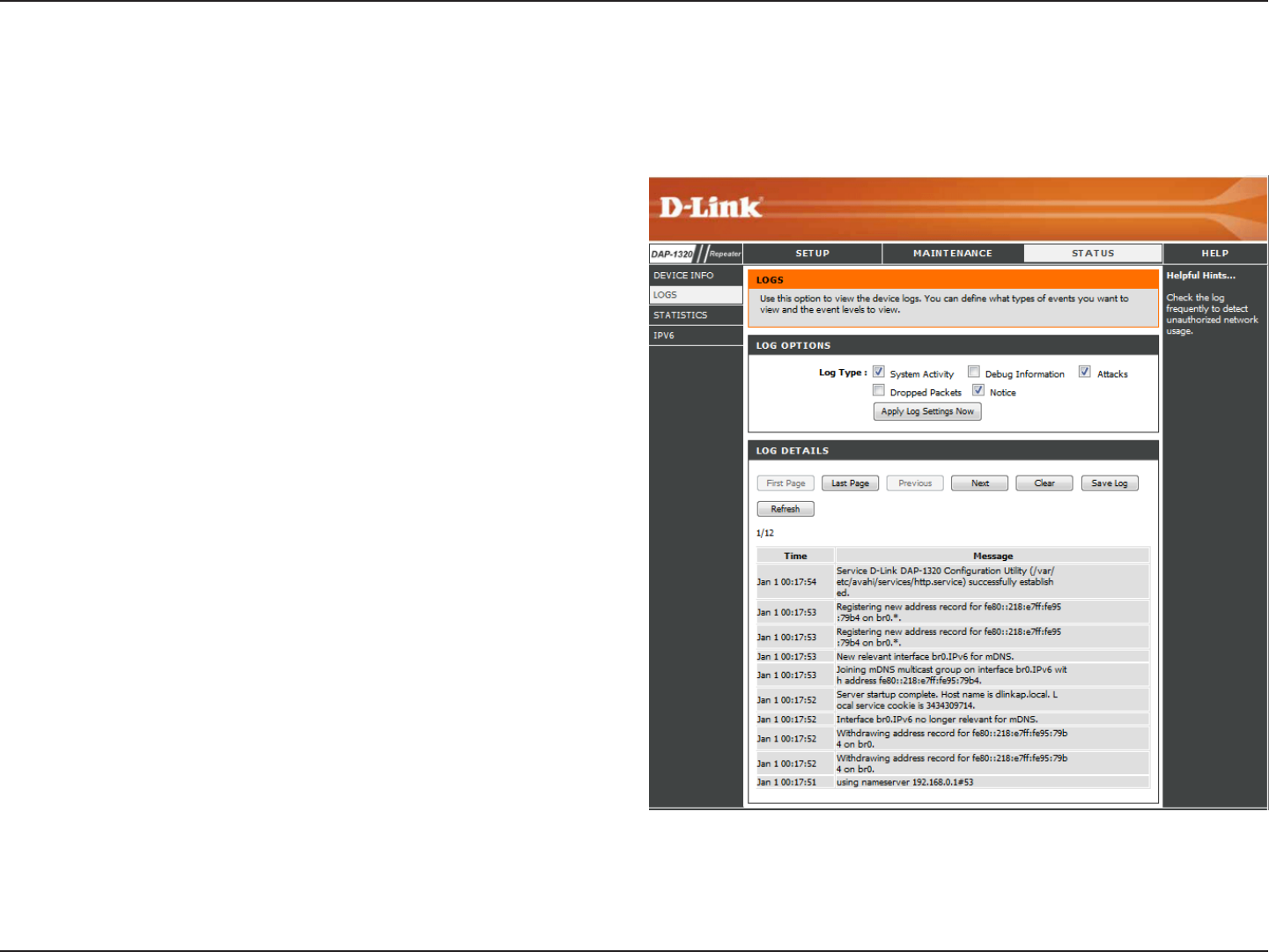
27D-Link DAP-1320 User Manual
Section 3 - Conguration
Log Options:
First Page:
Last Page:
Previous Page:
Next Page:
Clear Log:
Log Settings:
Refresh:
There are several types of logs that can be viewed:
System Activity, Debug Information, Attacks,
Dropped Packets and Notice.
This button directs you to the rst page of the log.
This button directs you to the last page of the log.
This button directs you to the previous page of
the log.
This button directs you to the next page of the log.
This button clears all current log content.
This button opens a new menu where you can
congure the log settings.
This button refreshes the log.
Logs
The DAP-1320 keeps a running log of events and activities occurring on the Repeater. If the Repeater is rebooted, the logs are
automatically cleared. You can save the log les under Log Setting.
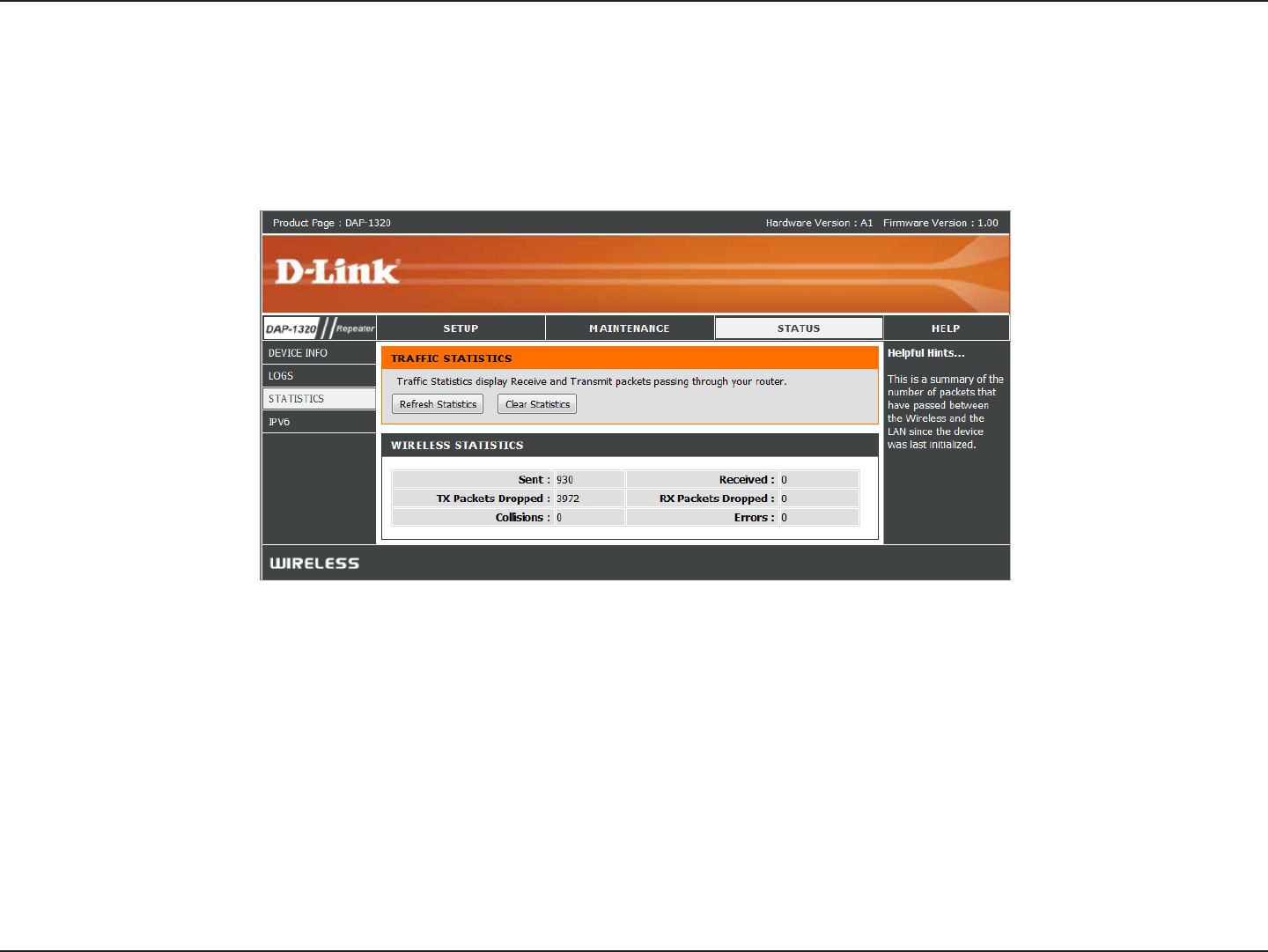
28D-Link DAP-1320 User Manual
Section 3 - Conguration
Statistics
The DAP-1320 keeps statistics of the trac that passes through it. You can view the amount of packets that pass through the
LAN and wireless portions of the network. The trac counter will reset if the access point is rebooted.
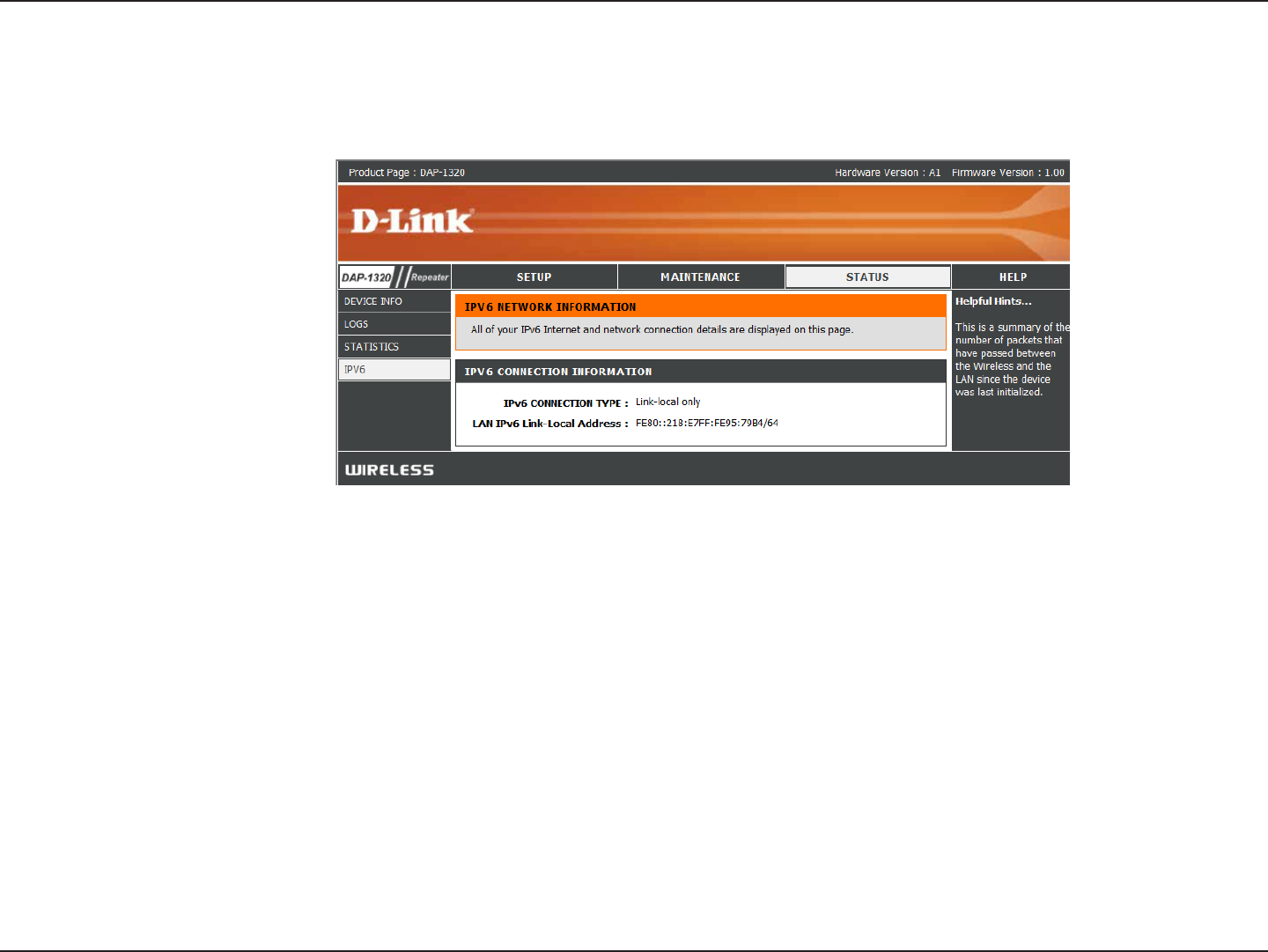
29D-Link DAP-1320 User Manual
Section 3 - Conguration
IPv6
This page displays all your IPv6 Internet and network connection information.
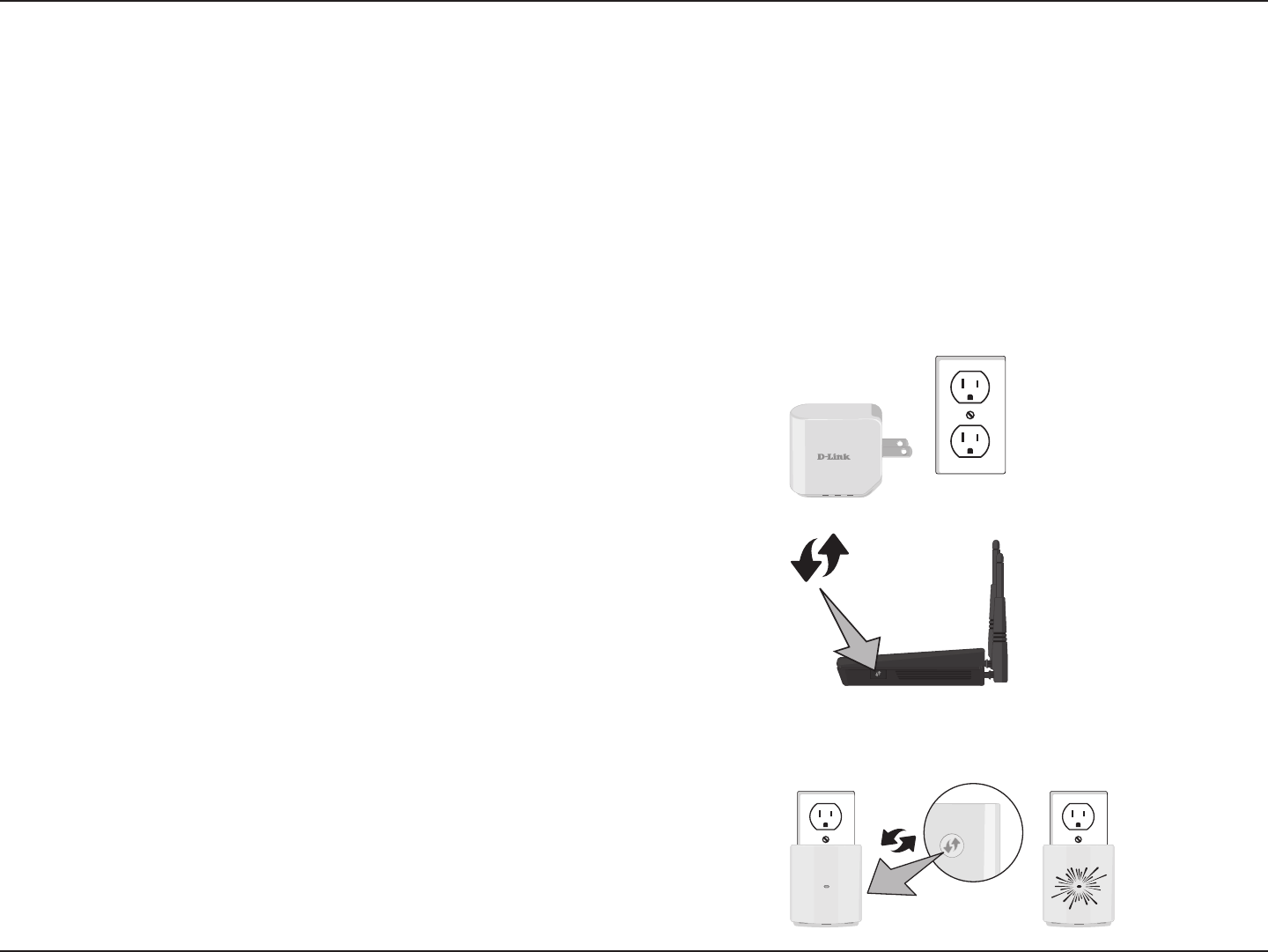
30D-Link DAP-1320 User Manual
Section 4 - Security
Connect a Wireless Client to your Router
WPS Button
Step 2 - Press the WPS button on your AP/Router.
The easiest and most secure way to connect your wireless devices to the router is WPS (Wi-Fi Protected Setup). Most wireless
devices such as wireless adapters, media players, Blu-ray DVD players, wireless printers and cameras will have a WPS button
(or a software utility with WPS) that you can press to connect to the DAP-1320 router. Please refer to your user manual for the
wireless device you want to connect to make sure you understand how to enable WPS. Once you know, follow the steps below:
Step 1 - Plug the DAP-1320 into a wall outlet and verify if the power
LED has turned from red to a blinking amber.
Step 3 - Press and hold the WPS button until the light starts blinking
green and then release. Please allow up to two minutes for
the WPS process to nish. Once the connection is successful
the LED will be solid green.
DAP-1320
WPS Button
WPS Button
Note: Usually the WPS LED will blink once it is pressed. Check your
router’s manual for more information.
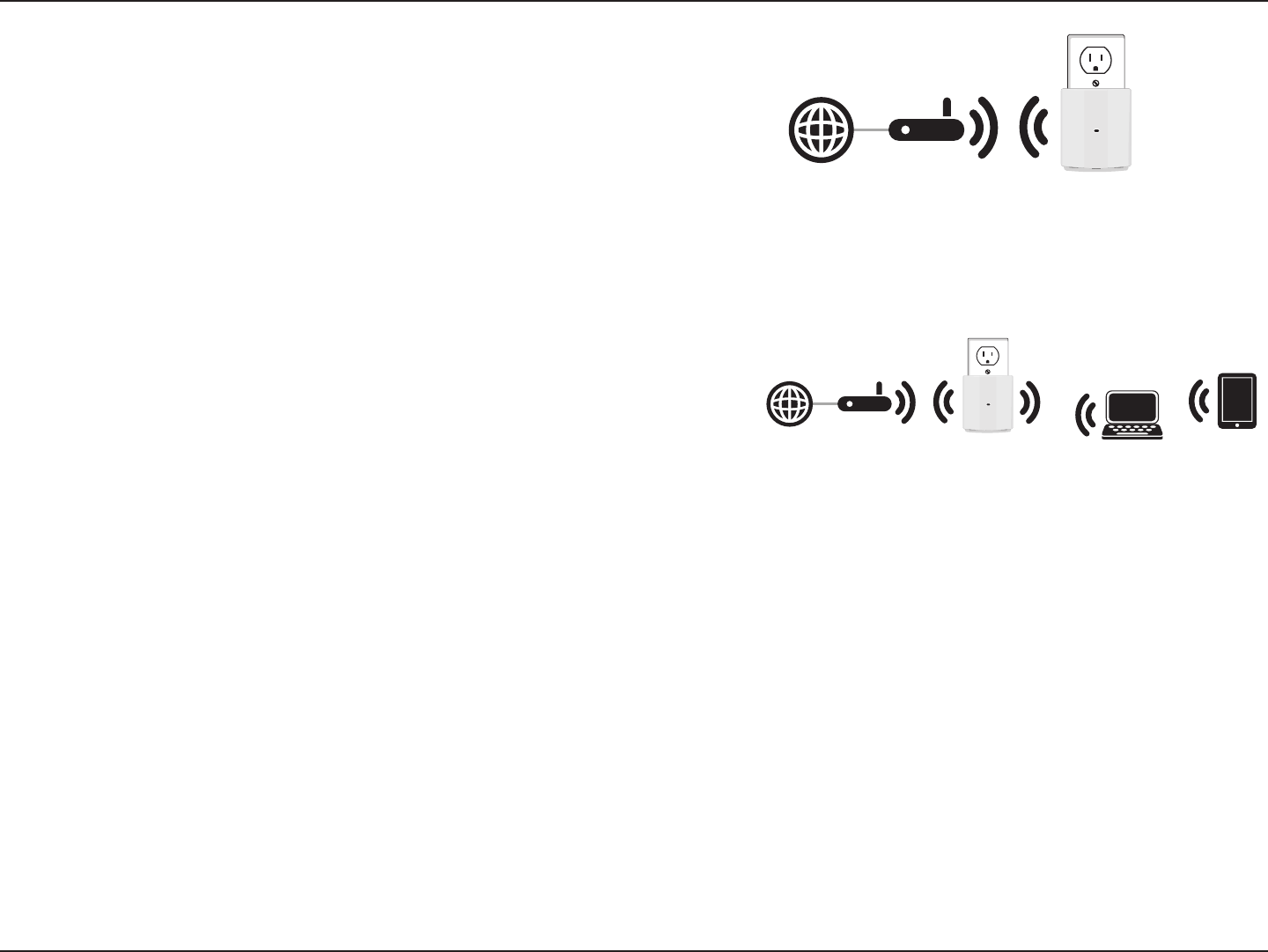
31D-Link DAP-1320 User Manual
Section 4 - Security
Step 5 - To connect wireless clients to the DAP-1320, use the SSID and
security key information located on your conguration card.
Step 4 - Your AP/Router and DAP-1320 will be connected when the LED
light turns solid green.
Note: If connection fails, try moving your DAP-1320 closer to your
wireless router/access point and repeat steps 2 and 3.
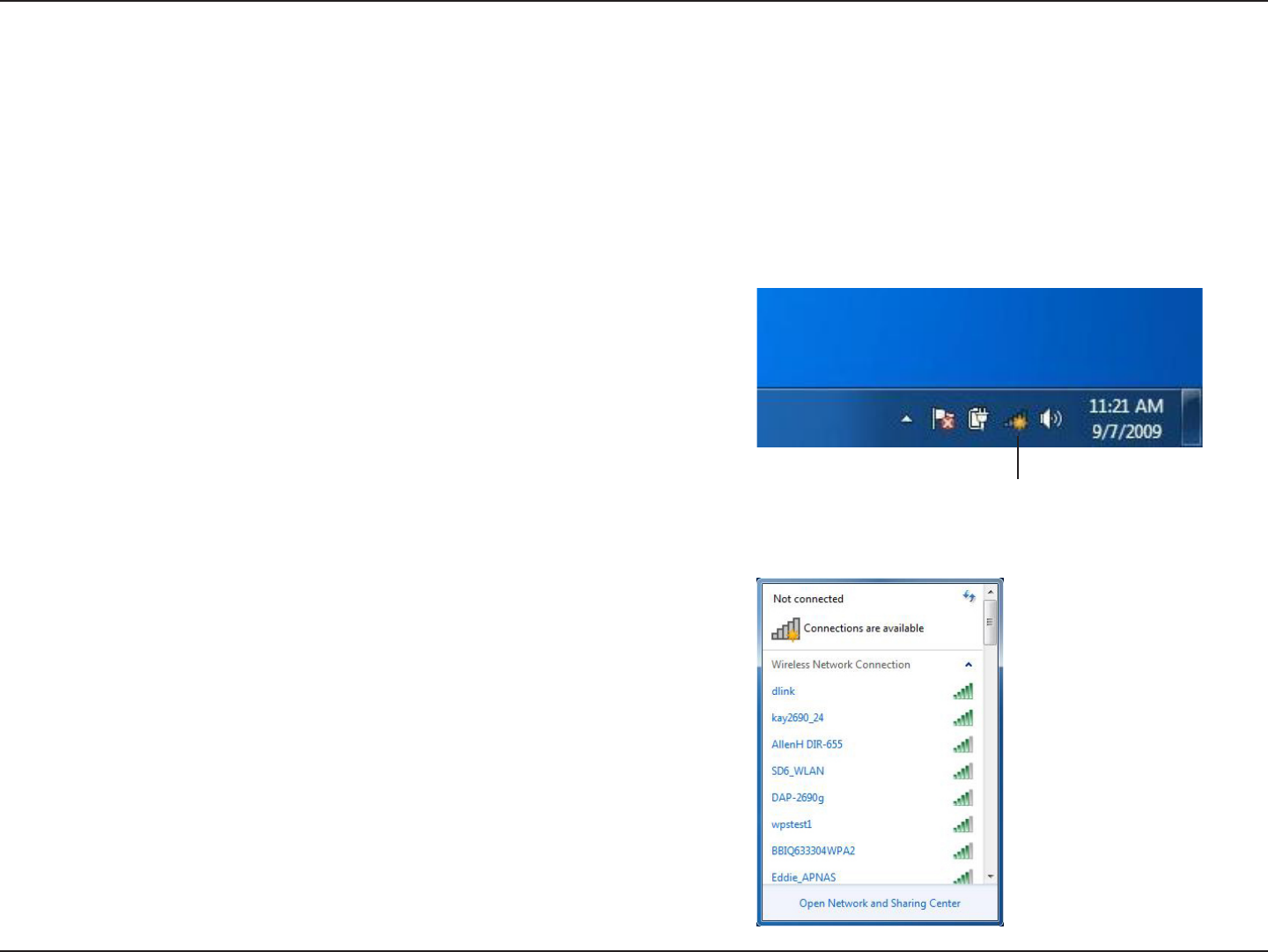
32D-Link DAP-1320 User Manual
Section 4 - Security
Windows® 7
It is recommended to enable wireless security (WPA/WPA2) on your wireless router or access point before conguring your
wireless adapter. If you are joining an existing network, you will need to know the security key or passphrase being used.
1. Click on the wireless icon in your system tray (lower-right corner).
2. The utility will display any available wireless networks in your area.
Wireless Icon
WPA/WPA2
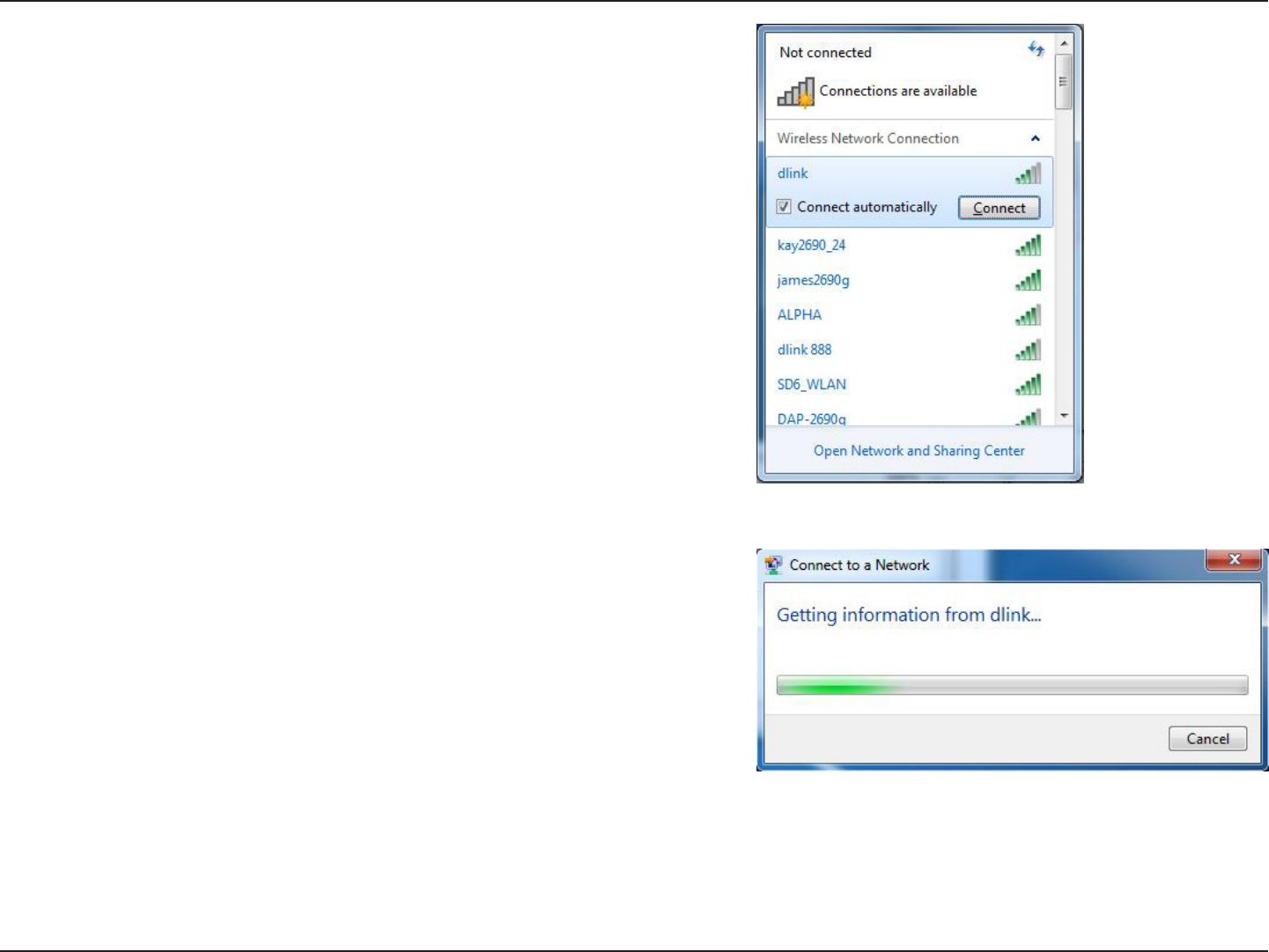
33D-Link DAP-1320 User Manual
Section 4 - Security
3. Highlight the wireless network (SSID) you would like to connect to
and click the Connect button.
If you get a good signal but cannot access the Internet, check your
TCP/IP settings for your wireless adapter. Refer to the Networking
Basics section in this manual for more information.
4. The following window appears while your computer tries to
connect to the router.
Note: You can nd the SSID and password on the conguration card.
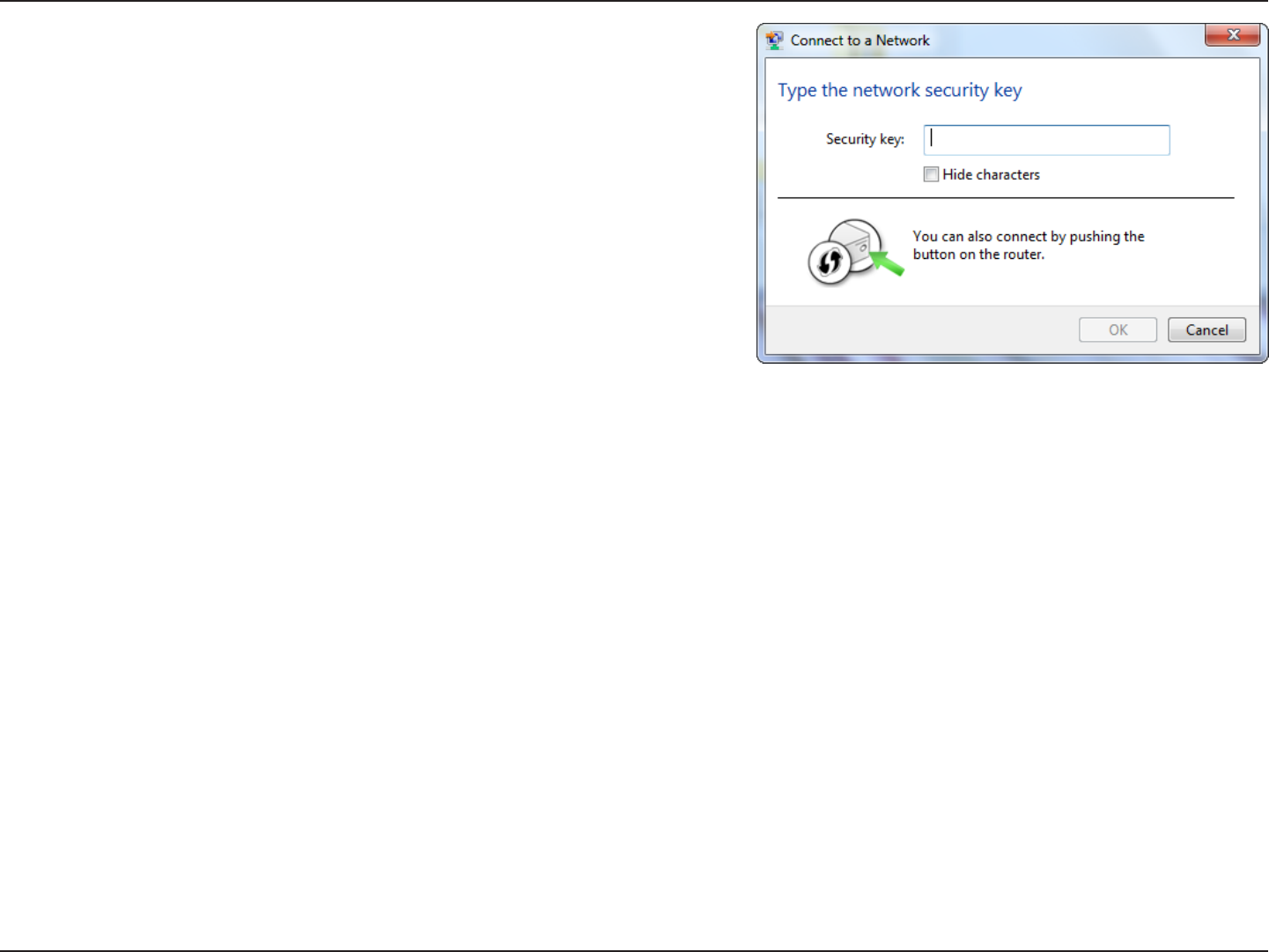
34D-Link DAP-1320 User Manual
Section 4 - Security
5. Enter the security key or passphrase that is on your conguration
card and click Connect. You can also connect by pushing the WPS
button on the DAP-1320.
It may take 20-30 seconds to connect to the wireless network. If the
connection fails, please verify that the security settings are correct. The
key or passphrase must be exactly the same as on the wireless router.
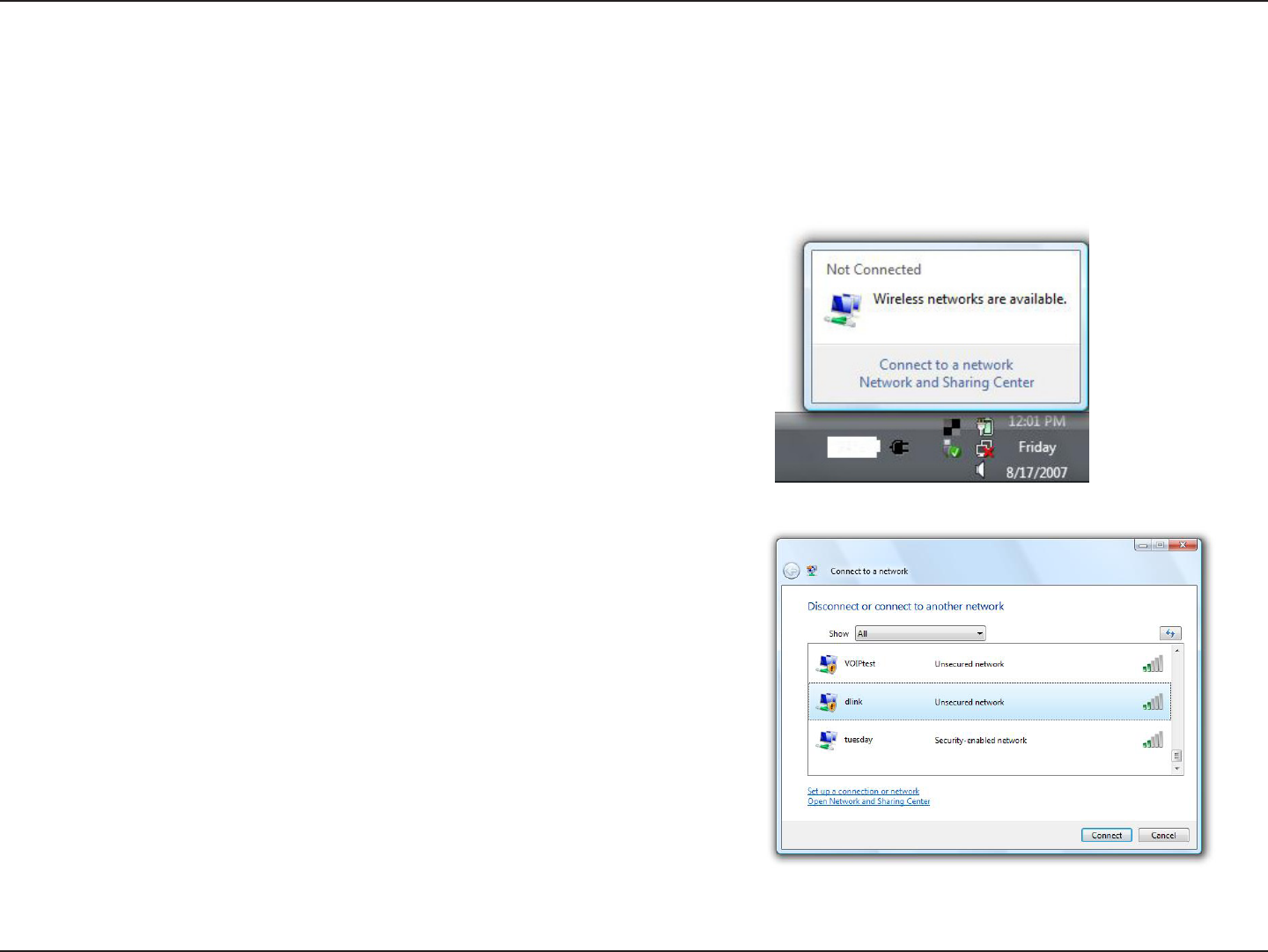
35D-Link DAP-1320 User Manual
Section 5 - Connecting to a Wireless Network
Windows Vista®
Windows Vista® users may use the built-in wireless utility. If you are using another company’s utility or Windows® 2000, please
refer to the user manual of your wireless adapter for help with connecting to a wireless network. Most utilities will have a “site
survey” option similar to the Windows Vista® utility as seen below.
Right-click on the wireless computer icon in your system tray (lower-right
corner next to the time). Select Connect to a network.
If you receive the Wireless Networks Detected bubble, click on the
center of the bubble to access the utility.
or
The utility will display any available wireless networks in your area. Click
on a network (displayed using the SSID) and click the Connect button.
If you get a good signal but cannot access the Internet, check you TCP/
IP settings for your wireless adapter. Refer to the Networking Basics
section in this manual for more information.
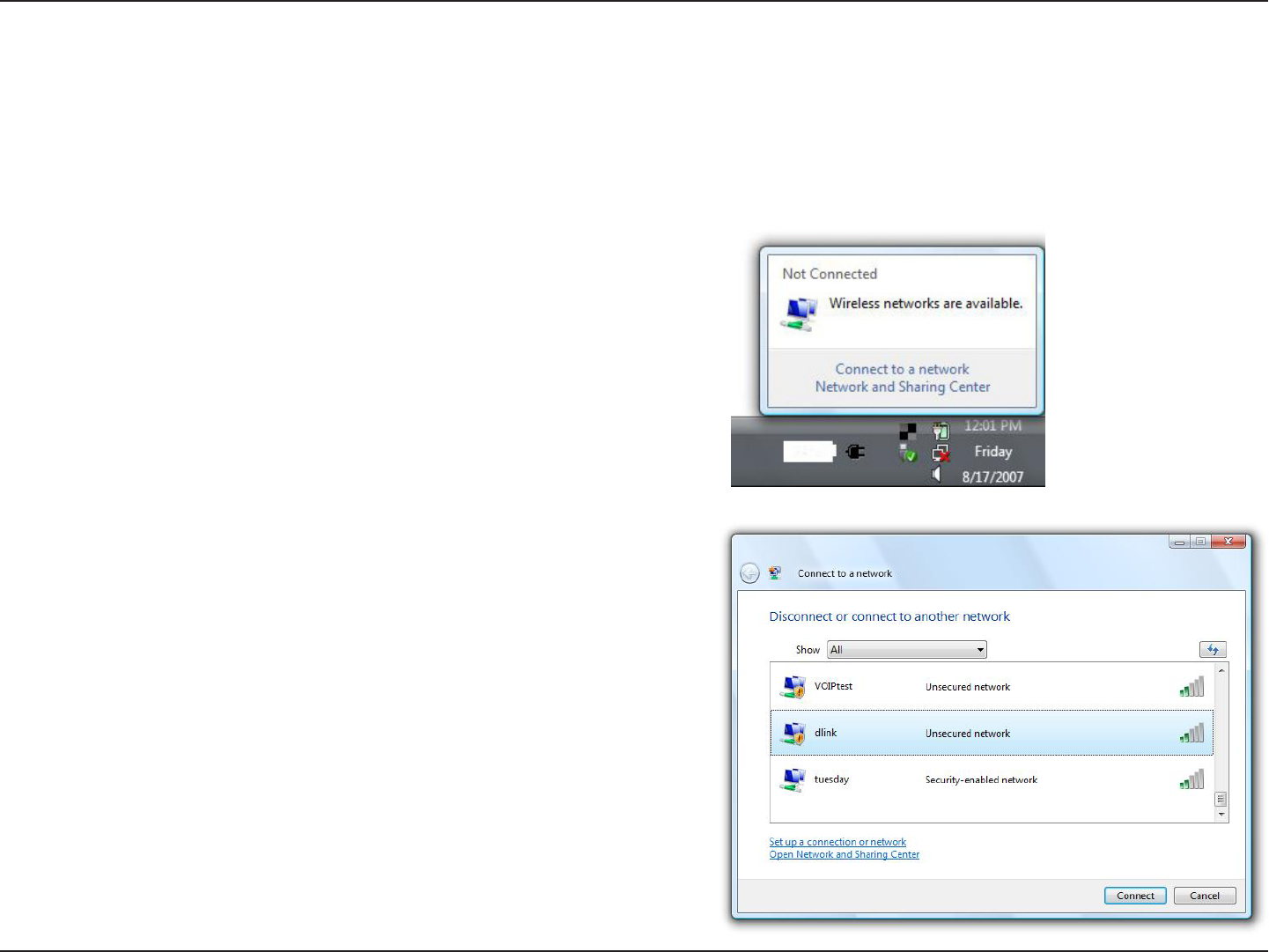
36D-Link DAP-1320 User Manual
Section 5 - Connecting to a Wireless Network
WPA/WPA2
It is recommended to enable wireless security (WPA/WPA2) on your wireless router or access point before conguring your
wireless adapter. If you are joining an existing network, you will need to know the security key or passphrase being used.
2. Highlight the wireless network (SSID) you would like to connect
to and click Connect.
1. Open the Windows Vista® Wireless Utility by right-clicking on the
wireless computer icon in your system tray (lower right corner of
screen). Select Connect to a network.
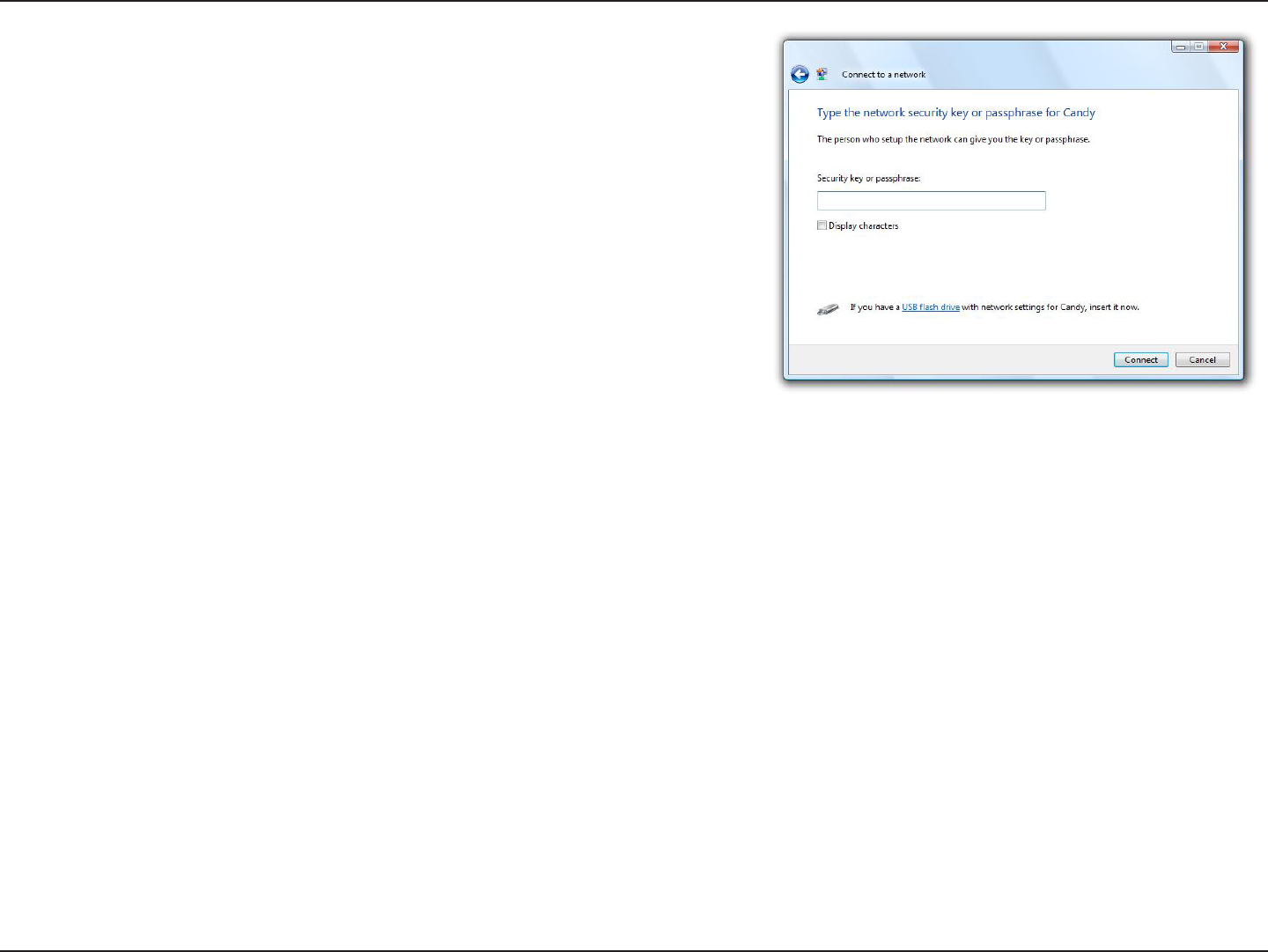
37D-Link DAP-1320 User Manual
Section 5 - Connecting to a Wireless Network
3. Enter the same security key or passphrase that is on your router and
click Connect.
It may take 20-30 seconds to connect to the wireless network. If the
connection fails, please verify that the security settings are correct. The
key or passphrase must be exactly the same as on the wireless router.
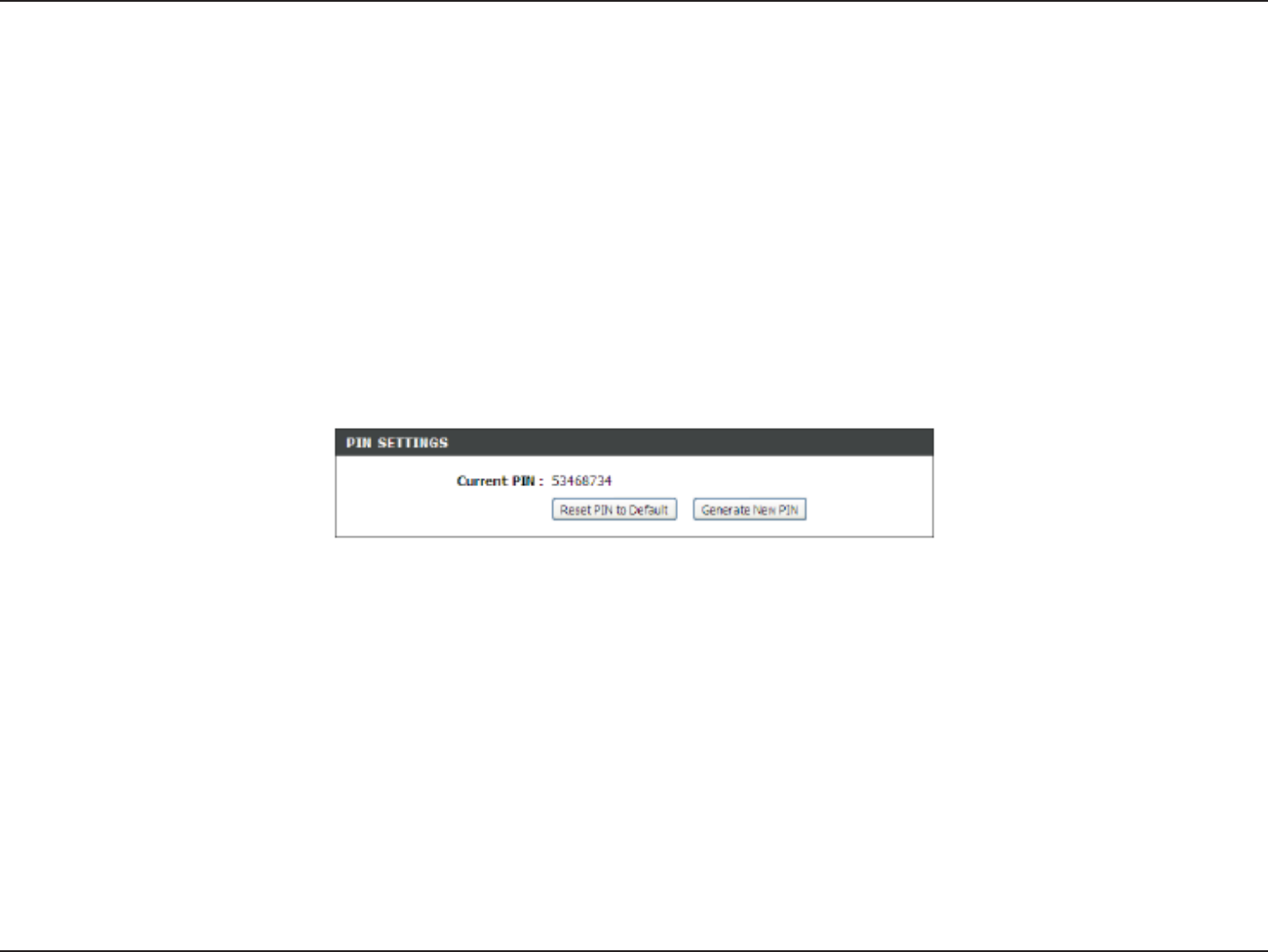
38D-Link DAP-1320 User Manual
Section 5 - Connecting to a Wireless Network
WPS/WCN 2.0
The router supports Wi-Fi protection, referred to as WCN 2.0 in Windows Vista®. The following instructions for setting this up
depends on whether you are using Windows Vista® to congure the router or third party software.
When you rst set up the router, Wi-Fi protection is disabled and uncongured. To enjoy the benets of Wi-Fi protection, the
router must be both enabled and congured. There are three basic methods to accomplish this: use Windows Vista’s built-in
support for WCN 2.0, use software provided by a third party, or manually congure.
If you are running Windows Vista®, log into the router and click the Enable checkbox in the Basic > Wireless section. Use the
Current PIN that is displayed on the Advanced > Wi-Fi Protected Setup section or choose to click the Generate New PIN
button or Reset PIN to Default button.
If you are using third party software to set up Wi-Fi Protection, carefully follow the directions. When you are nished, proceed
to the next section to set up the newly-congured router.
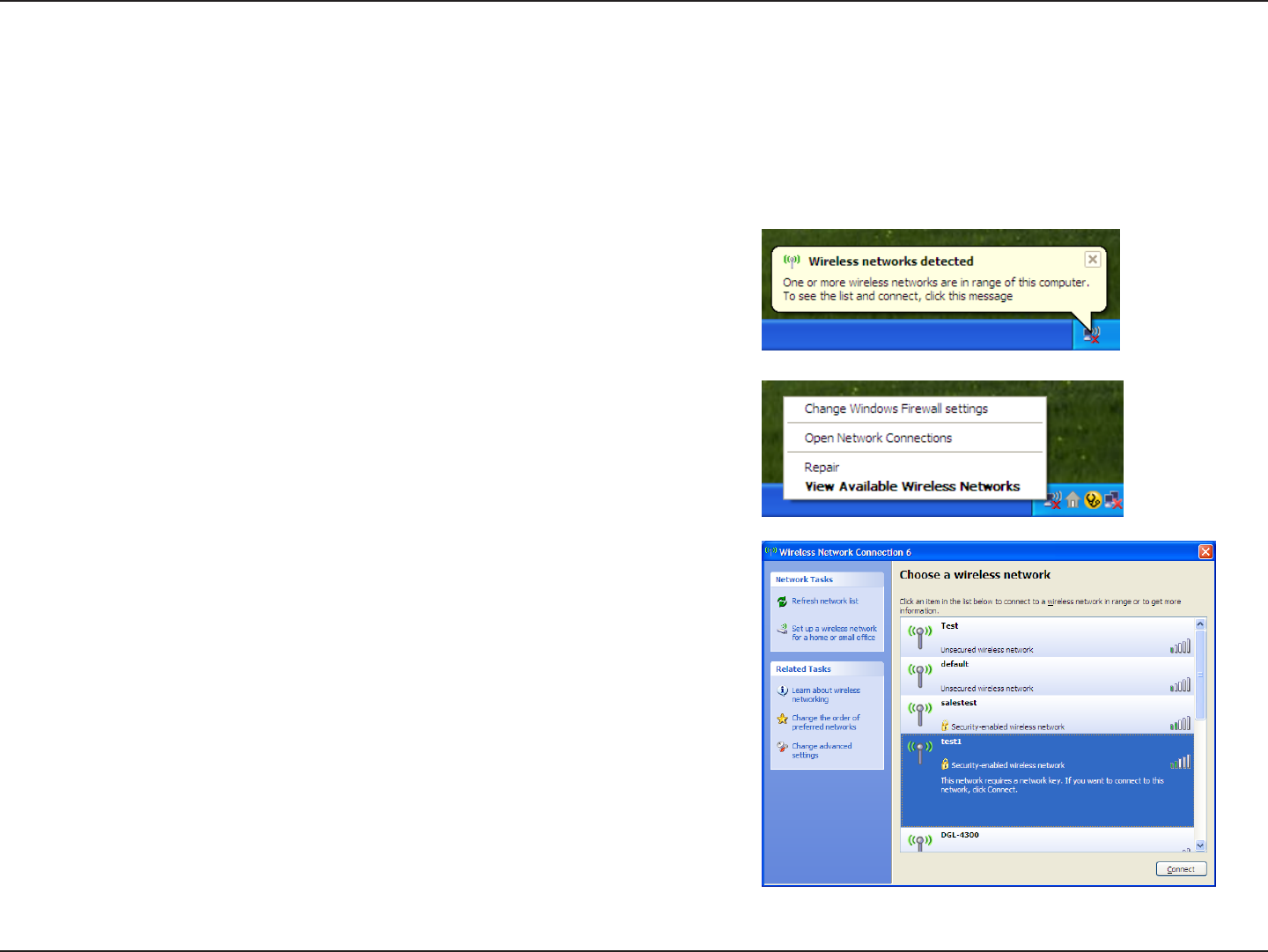
39D-Link DAP-1320 User Manual
Section 5 - Connecting to a Wireless Network
Windows® XP
Windows® XP users may use the built-in wireless utility (Zero Conguration Utility). The following instructions are for Service
Pack 2 users. If you are using another company’s utility, please refer to the user manual of your wireless adapter for help with
connecting to a wireless network. Most utilities will have a “site survey” option similar to the Windows® XP utility as seen below.
Right-click on the wireless computer icon in your system tray (lower-right
corner next to the time). Select View Available Wireless Networks.
If you receive the Wireless Networks Detected bubble, click on the
center of the bubble to access the utility.
or
The utility will display any available wireless networks in your area. Click
on a network (displayed using the SSID) and click the Connect button.
If you get a good signal but cannot access the Internet, check you TCP/
IP settings for your wireless adapter. Refer to the Networking Basics
section in this manual for more information.
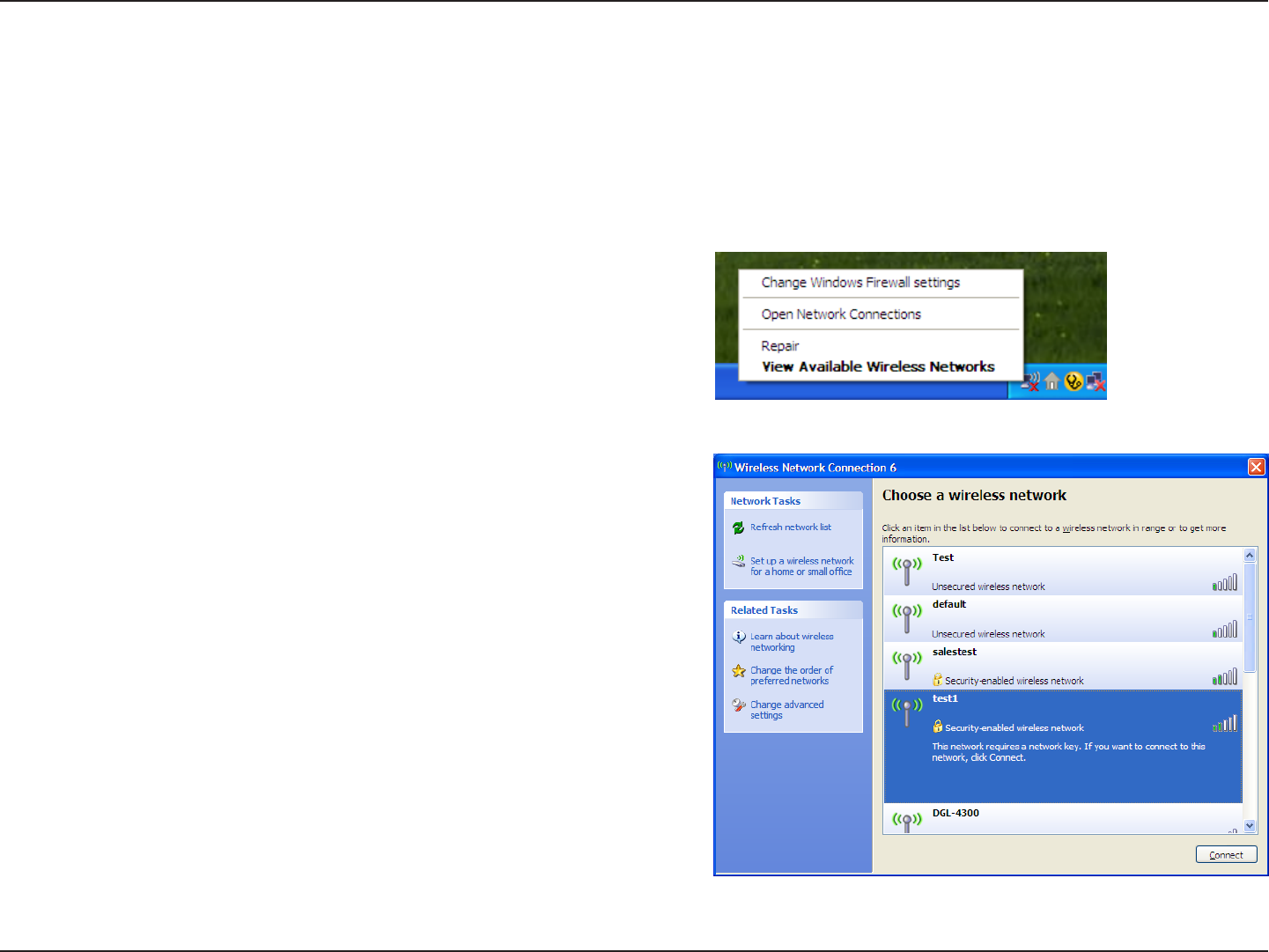
40D-Link DAP-1320 User Manual
Section 5 - Connecting to a Wireless Network
It is recommended to enable WPA on your wireless router or access point before conguring your wireless adapter. If you are
joining an existing network, you will need to know the WPA key being used.
2. Highlight the wireless network (SSID) you would like to
connect to and click Connect.
1. Open the Windows® XP Wireless Utility by right-clicking on the
wireless computer icon in your system tray (lower-right corner
of screen). Select View Available Wireless Networks.
WPA/WPA2
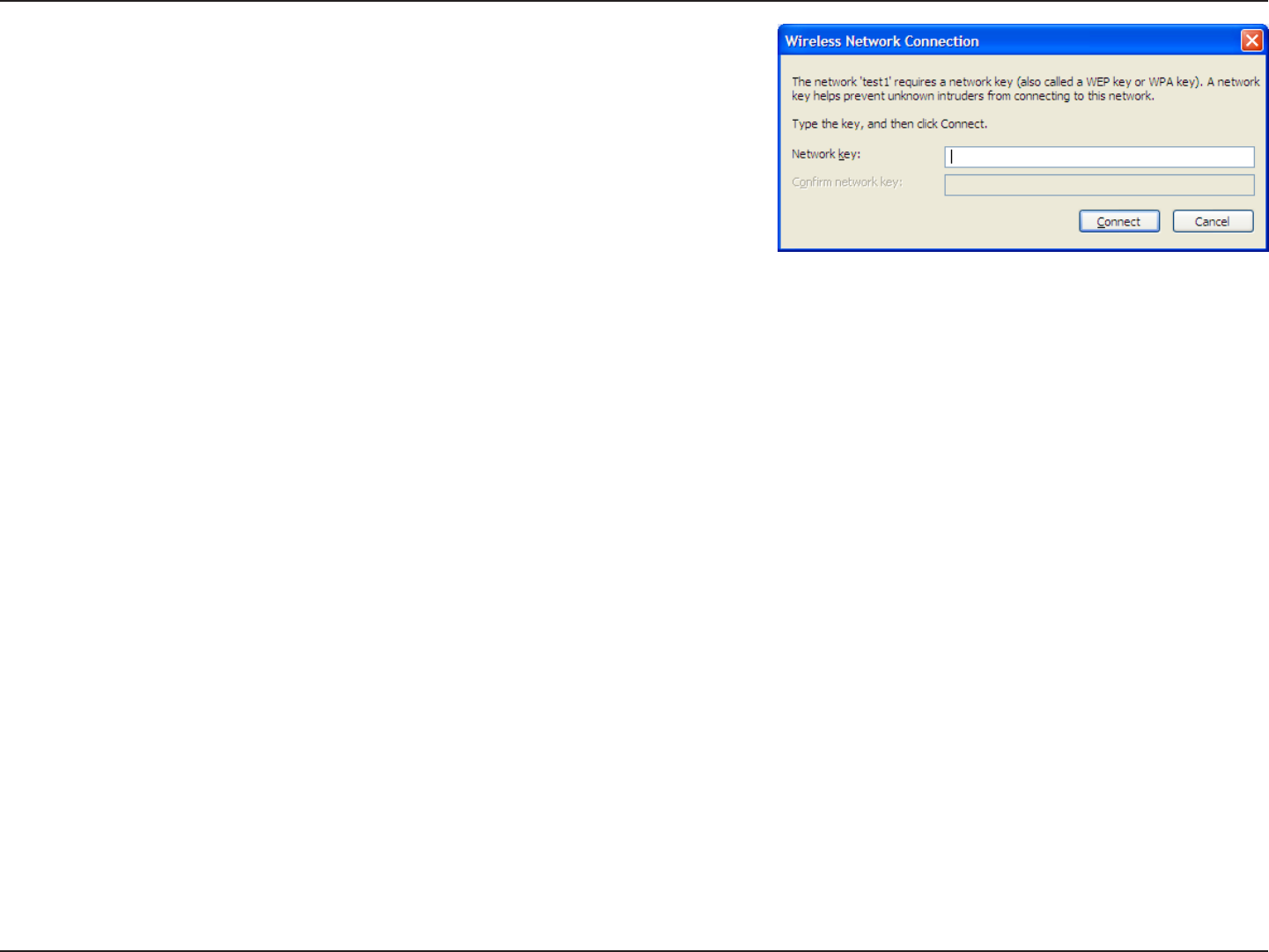
41D-Link DAP-1320 User Manual
Section 5 - Connecting to a Wireless Network
3. The Wireless Network Connection box will appear. Enter the WPA-PSK
passphrase and click Connect.
It may take 20-30 seconds to connect to the wireless network. If the
connection fails, please verify that the WPA-PSK settings are correct. The
WPA-PSK passphrase must be exactly the same as on the wireless router.

42D-Link DAP-1320 User Manual
Section 6 - Troubleshooting
Troubleshooting
This chapter provides solutions to problems that can occur during the installation and operation of the DAP-1320. Read the
following descriptions if you are having problems. The examples below are illustrated in Windows® XP. If you have a dierent
operating system, the screenshots on your computer will look similar to the following examples.
1. Why can’t I access the web-based conguration utility?
When entering the IP address of the D-Link router (192.168.0.1 for example), you are not connecting to a website nor do you
have to be connected to the Internet. The device has the utility built-in to a ROM chip in the device itself. Your computer must
be on the same IP subnet to connect to the web-based utility.
• Make sure you have an updated Java-enabled web browser. We recommend the following:
- Microsoft Internet Explorer® 6.0 and higher
- Mozilla Firefox 3.0 and higher
- Google™ Chrome 2.0 and higher
- Apple Safari 4.0 and higher
• Verify physical connectivity by checking for solid link lights on the device. If you do not get a solid link light, try using a
dierent cable or connect to a dierent port on the device if possible. If the computer is turned o, the link light may not be
on.
• Disable any Internet security software running on the computer. Software rewalls such as Zone Alarm, Black Ice, Sygate,
Norton Personal Firewall, and Windows® XP rewall may block access to the conguration pages. Check the help les included
with your rewall software for more information on disabling or conguring it.

43D-Link DAP-1320 User Manual
Section 6 - Troubleshooting
• Congure your Internet settings:
• Go to Start > Settings > Control Panel. Double-click the Internet Options Icon. From the Security tab, click
the button to restore the settings to their defaults.
• Click the Connection tab and set the dial-up option to Never Dial a Connection. Click the LAN Settings button.
Make sure nothing is checked. Click OK.
• Go to the Advanced tab and click the button to restore these settings to their defaults. Click OK three times.
• Close your web browser (if open) and open it.
• Access the web management. Open your web browser and enter the IP address of your D-Link router in the address bar. This
should open the login page for your web management.
• If you still cannot access the conguration, unplug the power to the router for 10 seconds and plug back in. Wait about 30
seconds and try accessing the conguration. If you have multiple computers, try connecting using a dierent computer.
2. What can I do if I forgot my password?
If you forgot your password, you must reset your router. Unfortunately this process will change all your settings back to the
factory defaults.
To reset the router, locate the reset button (hole) on the rear panel of the unit. With the router powered on, use a paperclip
to hold the button down for 10 seconds. Release the button and the router will go through its reboot process. Wait about 30
seconds to access the router. The default IP address is 192.168.0.50. When logging in, the username is admin and leave the
password box empty.

44D-Link DAP-1320 User Manual
Appendix A - Wireless Basics
D-Link wireless products are based on industry standards to provide easy-to-use and compatible high-speed wireless
connectivity within your home, business or public access wireless networks. Strictly adhering to the IEEE standard, the D-Link
wireless family of products will allow you to securely access the data you want, when and where you want it. You will be able
to enjoy the freedom that wireless networking delivers.
A wireless local area network (WLAN) is a cellular computer network that transmits and receives data with radio signals instead of
wires. Wireless LANs are used increasingly in both home and oce environments, and public areas such as airports, coee shops
and universities. Innovative ways to utilize WLAN technology are helping people to work and communicate more eciently.
Increased mobility and the absence of cabling and other xed infrastructure have proven to be benecial for many users.
Wireless users can use the same applications they use on a wired network. Wireless adapter cards used on laptop and desktop
systems support the same protocols as Ethernet adapter cards.
Under many circumstances, it may be desirable for mobile network devices to link to a conventional Ethernet LAN in order to
use servers, printers or an Internet connection supplied through the wired LAN. A Wireless Router is a device used to provide
this link.
Wireless Basics

45D-Link DAP-1320 User Manual
Appendix A - Wireless Basics
What is Wireless?
Wireless or Wi-Fi technology is another way of connecting your computer to the network without using wires. Wi-Fi uses radio
frequency to connect wirelessly, so you have the freedom to connect computers anywhere in your home or oce network.
Why D-Link Wireless?
D-Link is the worldwide leader and award winning designer, developer, and manufacturer of networking products. D-Link
delivers the performance you need at a price you can aord. D-Link has all the products you need to build your network.
How does wireless work?
Wireless works similar to how cordless phone work, through radio signals to transmit data from one point A to point B. But
wireless technology has restrictions as to how you can access the network. You must be within the wireless network range area
to be able to connect your computer. There are two dierent types of wireless networks Wireless Local Area Network (WLAN),
and Wireless Personal Area Network (WPAN).
Wireless Local Area Network (WLAN)
In a wireless local area network, a device called an Access Point (AP) connects computers to the network. The access point has
a small antenna attached to it, which allows it to transmit data back and forth over radio signals. With an indoor access point
as seen in the picture, the signal can travel up to 300 feet. With an outdoor access point the signal can reach out up to 30 miles
to serve places like manufacturing plants, industrial locations, college and high school campuses, airports, golf courses, and
many other outdoor venues.

46D-Link DAP-1320 User Manual
Appendix A - Wireless Basics
Wireless Personal Area Network (WPAN)
Bluetooth is the industry standard wireless technology used for WPAN. Bluetooth devices in WPAN operate in a range up to
30 feet away.
Compared to WLAN the speed and wireless operation range are both less than WLAN, but in return it doesn’t use nearly as
much power which makes it ideal for personal devices, such as mobile phones, PDAs, headphones, laptops, speakers, and other
devices that operate on batteries.
Who uses wireless?
Wireless technology as become so popular in recent years that almost everyone is using it, whether it’s for home, oce, business,
D-Link has a wireless solution for it.
Home
• Gives everyone at home broadband access
• Surf the web, check email, instant message, etc.
• Gets rid of the cables around the house
• Simple and easy to use
Small Oce and Home Oce
• Stay on top of everything at home as you would at oce
• Remotely access your oce network from home
• Share Internet connection and printer with multiple computers
• No need to dedicate oce space

47D-Link DAP-1320 User Manual
Appendix A - Wireless Basics
Where is wireless used?
Wireless technology is expanding everywhere not just at home or oce. People like the freedom of mobility and it’s becoming
so popular that more and more public facilities now provide wireless access to attract people. The wireless connection in public
places is usually called “hotspots”.
Using a D-Link Cardbus Adapter with your laptop, you can access the hotspot to connect to Internet from remote locations
like: Airports, Hotels, Coee Shops, Libraries, Restaurants, and Convention Centers.
Wireless network is easy to setup, but if you’re installing it for the rst time it could be quite a task not knowing where to start.
That’s why we’ve put together a few setup steps and tips to help you through the process of setting up a wireless network.
Tips
Here are a few things to keep in mind, when you install a wireless network.
Centralize your router or Access Point
Make sure you place the router/access point in a centralized location within your network for the best performance. Try to
place the router/access point as high as possible in the room, so the signal gets dispersed throughout your home. If you have
a two-story home, you may need a repeater to boost the signal to extend the range.
Eliminate Interference
Place home appliances such as cordless telephones, microwaves, and televisions as far away as possible from the router/access
point. This would signicantly reduce any interference that the appliances might cause since they operate on same frequency.
Security
Don’t let you next-door neighbors or intruders connect to your wireless network. Secure your wireless network by turning on
the WPA or WEP security feature on the router. Refer to product manual for detail information on how to set it up.
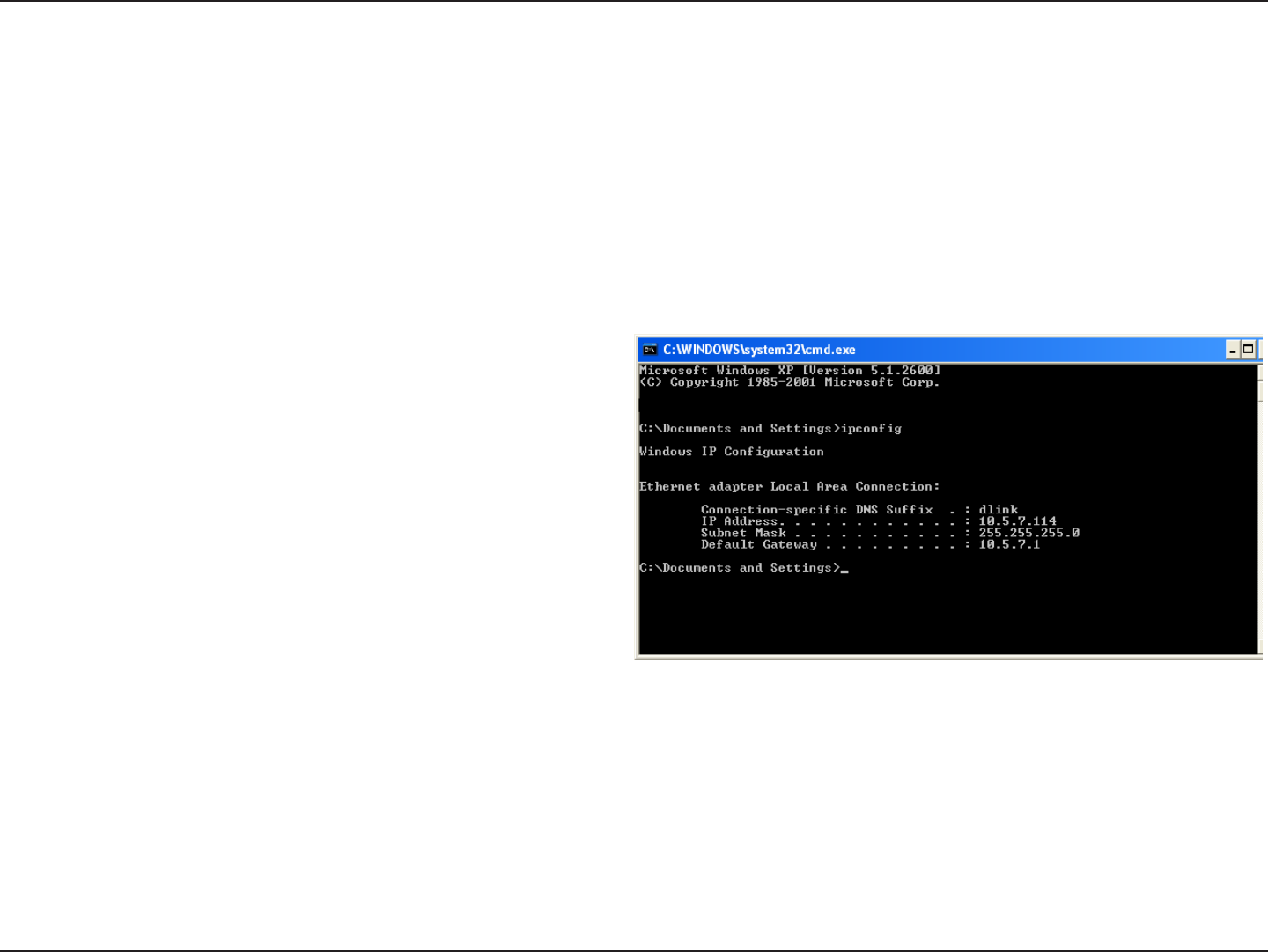
48D-Link DAP-1320 User Manual
Appendix B - Networking Basics
Networking Basics
Check your IP address
After you install your new D-Link adapter, by default, the TCP/IP settings should be set to obtain an IP address from a DHCP
server (i.e. wireless router) automatically. To verify your IP address, please follow the steps below.
Click on Start > Run. In the run box type cmd and click OK. (Windows® 7/Vista® users type cmd in the Start Search box.)
At the prompt, type ipcong and press Enter.
This will display the IP address, subnet mask, and the default
gateway of your adapter.
If the address is 0.0.0.0, check your adapter installation,
security settings, and the settings on your router. Some
rewall software programs may block a DHCP request on
newly installed adapters.
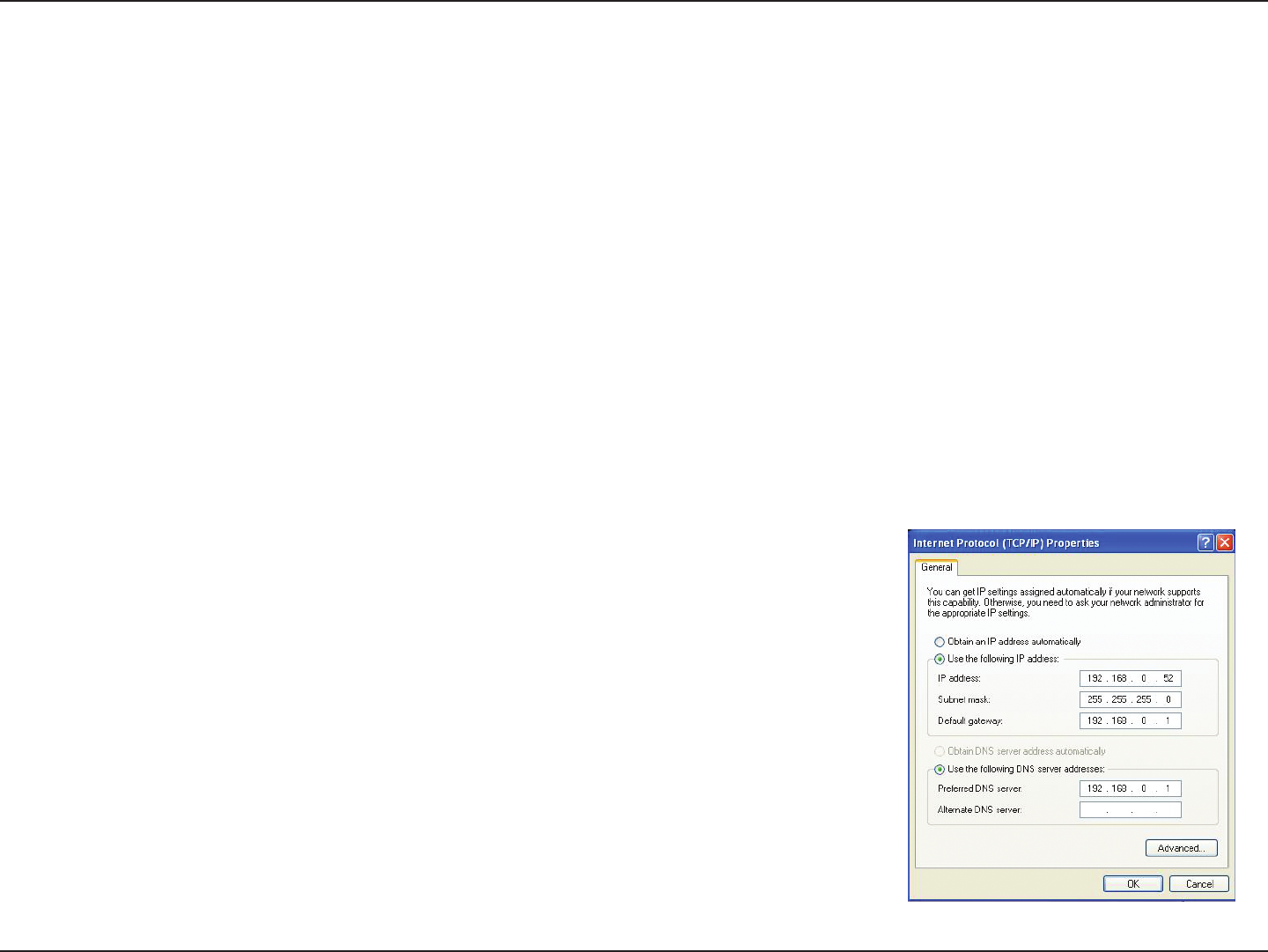
49D-Link DAP-1320 User Manual
Appendix B - Networking Basics
Statically Assign an IP address
If you are not using a DHCP capable gateway/router, or you need to assign a static IP address, please follow the steps below:
Step 1
Windows® 7 - Click on Start > Control Panel > Network and Internet > Network and Sharing Center.
Windows Vista® - Click on Start > Control Panel > Network and Internet > Network and Sharing Center > Manage Network
Connections.
Windows® XP - Click on Start > Control Panel > Network Connections.
Windows® 2000 - From the desktop, right-click My Network Places > Properties.
Step 2
Right-click on the Local Area Connection which represents your network adapter and select Properties.
Step 3
Highlight Internet Protocol (TCP/IP) and click Properties.
Step 4
Click Use the following IP address and enter an IP address that is on the same subnet
as your network or the LAN IP address on your router.
Example: If the router´s LAN IP address is 192.168.0.1, make your IP address 192.168.0.X
where X is a number between 2 and 99. Make sure that the number you choose is not
in use on the network. Set the Default Gateway the same as the LAN IP address of your
router (I.E. 192.168.0.1).
Set Primary DNS the same as the LAN IP address of your router (192.168.0.1). The
Secondary DNS is not needed or you may enter a DNS server from your ISP.
Step 5
Click OK twice to save your settings.

50D-Link DAP-1320 User Manual
Appendix C - Technical Specications
Technical Specications
Standards
• IEEE 802.11n
• IEEE 802.11g
• IEEE 802.3
• IEEE 802.3u
Wireless Frequency Range
• 2.4 GHz to 2.4835 GHz
Antennas
• Internal Antenna
Security
• Wi-Fi Protected Access (WPA/WPA2)
• WPS™ (PBC)
Advanced Features
• Quick Router Setup app for iOS
Device Management
• Web UI
Diagnostic LEDs
• Power/WPS
Operating Temperature
• 32 to 104 ˚F (0 to 40 ˚C)
Operating Humidity
• 0% to 90% non-condensing
Certications
• CE
• Wi-Fi Certied
• FCC
• IC
Dimensions
• 2.68” x 1.65” x 2” (68 x 42 x 51 mm )
Weight
• 0.25 lb (113.4 grams)
Warranty
• 1-Year Limited Warranty
1 Maximum wireless signal rate derived from IEEE Standard 802.11g and 802.11n specications. Actual data throughput will vary. Network conditions and environmental factors, including volume
of network trac, building materials and construction, and network overhead, lower actual data throughput rate. Environmental factors will adversely aect wireless signal range.
2 Frequency Range varies depending on country’s regulation

51D-Link DAP-1320 User Manual
Appendix D - Contacting Technical Support
Contacting Technical Support
U.S. and Canadian customers can contact D-Link technical support through our web site or by phone.
Before you contact technical support, please have the following ready:
• Model number of the product (e.g. DAP-1320)
• Hardware Revision (located on the label on the bottom of the router (e.g. rev A1))
• Serial Number (s/n number located on the label on the bottom of the router).
You can nd software updates and user documentation on the D-Link website as well as frequently asked questions and
answers to technical issues.
For customers within the United States:
Phone Support:
(877) 453-5465
Internet Support:
http://support.dlink.com
For customers within Canada:
Phone Support:
(800) 361-5265
Internet Support:
http://support.dlink.ca

52D-Link DAP-1320 User Manual
Appendix F - Warranty
Warranty
Subject to the terms and conditions set forth herein, D-Link Systems, Inc. (“D-Link”) provides this Limited Warranty:
• Only to the person or entity that originally purchased the product from D-Link or its authorized reseller or distributor, and
• Only for products purchased and delivered within the fty states of the United States, the District of Columbia, U.S. Possessions
or Protectorates, U.S. Military Installations, or addresses with an APO or FPO.
Limited Warranty:
D-Link warrants that the hardware portion of the D-Link product described below (“Hardware”) will be free from material defects in workmanship
and materials under normal use from the date of original retail purchase of the product, for the period set forth below (“Warranty Period”), except
as otherwise stated herein.
• Hardware (excluding power supplies and fans): One (1) year
• Power supplies and fans: One (1) year
• Spare parts and spare kits: Ninety (90) days
The customer’s sole and exclusive remedy and the entire liability of D-Link and its suppliers under this Limited Warranty will be, at
D-Link’s option, to repair or replace the defective Hardware during the Warranty Period at no charge to the original owner or to refund the actual
purchase price paid. Any repair or replacement will be rendered by D-Link at an Authorized D-Link Service Oce. The replacement hardware
need not be new or have an identical make, model or part. D-Link may, at its option, replace the defective Hardware or any part thereof with any
reconditioned product that D-Link reasonably determines is substantially equivalent (or superior) in all material respects to the defective Hardware.
Repaired or replacement hardware will be warranted for the remainder of the original Warranty Period or ninety (90) days, whichever is longer,
and is subject to the same limitations and exclusions. If a material defect is incapable of correction, or if D-Link determines that it is not practical
to repair or replace the defective Hardware, the actual price paid by the original purchaser for the defective Hardware will be refunded by D-Link
upon return to D-Link of the defective Hardware. All Hardware or part thereof that is replaced by D-Link, or for which the purchase price is refunded,
shall become the property of D-Link upon replacement or refund.

53D-Link DAP-1320 User Manual
Appendix F - Warranty
Limited Software Warranty:
D-Link warrants that the software portion of the product (“Software”) will substantially conform to D-Link’s then current functional specications
for the Software, as set forth in the applicable documentation, from the date of original retail purchase of the Software for a period of ninety (90)
days (“Software Warranty Period”), provided that the Software is properly installed on approved hardware and operated as contemplated in its
documentation. D-Link further warrants that, during the Software Warranty Period, the magnetic media on which D-Link delivers the Software will be
free of physical defects. The customer’s sole and exclusive remedy and the entire liability of D-Link and its suppliers under this Limited Warranty will
be, at D-Link’s option, to replace the non-conforming Software (or defective media) with software that substantially conforms to D-Link’s functional
specications for the Software or to refund the portion of the actual purchase price paid that is attributable to the Software. Except as otherwise
agreed by D-Link in writing, the replacement Software is provided only to the original licensee, and is subject to the terms and conditions of the
license granted by D-Link for the Software. Replacement Software will be warranted for the remainder of the original Warranty Period and is subject
to the same limitations and exclusions. If a material non-conformance is incapable of correction, or if D-Link determines in its sole discretion that it
is not practical to replace the non-conforming Software, the price paid by the original licensee for the non-conforming Software will be refunded by
D-Link; provided that the non-conforming Software (and all copies thereof) is rst returned to D-Link. The license granted respecting any Software
for which a refund is given automatically terminates.
Non-Applicability of Warranty:
The Limited Warranty provided hereunder for Hardware and Software portions of D-Link’s products will not be applied to and does not cover any
refurbished product and any product purchased through the inventory clearance or liquidation sale or other sales in which D-Link, the sellers, or
the liquidators expressly disclaim their warranty obligation pertaining to the product and in that case, the product is being sold “As-Is” without any
warranty whatsoever including, without limitation, the Limited Warranty as described herein, notwithstanding anything stated herein to the contrary.
Submitting A Claim (USA):
The customer shall return the product to the original purchase point based on its return policy. In case the return policy period has expired and
the product is within warranty, the customer shall submit a claim to D-Link as outlined below:
• The customer must submit with the product as part of the claim a written description of the Hardware defect or Software
nonconformance in sucient detail to allow DLink to conrm the same, along with proof of purchase of the product (such as a
copy of the dated purchase invoice for the product) if the product is not registered.
• The customer must obtain a Case ID Number from D-Link Technical Support at 1-877-453-5465, who will attempt to assist the
customer in resolving any suspected defects with the product. If the product is considered defective, the customer must obtain a
Return Material Authorization (“RMA”) number by completing the RMA form and entering the assigned Case ID Number at https://
rma.dlink.com/.

54D-Link DAP-1320 User Manual
Appendix F - Warranty
• After an RMA number is issued, the defective product must be packaged securely in the original or other suitable shipping package
to ensure that it will not be damaged in transit, and the RMA number must be prominently marked on the outside of the package.
Do not include any manuals or accessories in the shipping package. D-Link will only replace the defective portion of the product
and will not ship back any accessories.
• The customer is responsible for all in-bound shipping charges to D-Link. No Cash on Delivery (“COD”) is allowed. Products sent COD
will either be rejected by D-Link or become the property of D-Link. Products shall be fully insured by the customer and shipped
to D-Link Systems, Inc., 17595 Mt. Herrmann, Fountain Valley, CA 92708. D-Link will not be held responsible for any packages that
are lost in transit to D-Link. The repaired or replaced packages will be shipped to the customer via UPS Ground or any common
carrier selected by D-Link. Return shipping charges shall be prepaid by D-Link if you use an address in the United States, otherwise
we will ship the product to you freight collect. Expedited shipping is available upon request and provided shipping charges are
prepaid by the customer. D-Link may reject or return any product that is not packaged and shipped in strict compliance with the
foregoing requirements, or for which an RMA number is not visible from the outside of the package. The product owner agrees to
pay D-Link’s reasonable handling and return shipping charges for any product that is not packaged and shipped in accordance
with the foregoing requirements, or that is determined by D-Link not to be defective or non-conforming.
Submitting A Claim (Canada):
The customer shall return the product to the original purchase point based on its return policy. In case the return policy period has expired and
the product is within warranty, the customer shall submit a claim to D-Link as outlined below:
• Customers need to provide their receipt (proof of purchase) even if the product is registered. Without a receipt, no warranty service will
be done. The registration is not considered a proof of purchase.
• The customer must submit with the product as part of the claim a written description of the Hardware defect or Software nonconformance
in sucient detail to allow D-Link to conrm the same, along with proof of purchase of the product (such as a copy of the dated purchase
invoice for the product) if the product is not registered.
• The customer must obtain a Case ID Number from D-Link Technical Support at 1-800-361-5265, who will attempt to assist the customer
in resolving any suspected defects with the product. If the product is considered defective, the customer must obtain a Return Material
Authorization (“RMA”) number by completing the RMA form and entering the assigned Case ID Number at https://rma.dlink.ca/.
• After an RMA number is issued, the defective product must be packaged securely in the original or other suitable shipping package to
ensure that it will not be damaged in transit, and the RMA number must be prominently marked on the outside of the package. Do not
include any manuals or accessories in the shipping package. D-Link will only replace the defective portion of the product and will not ship
back any accessories.

55D-Link DAP-1320 User Manual
Appendix F - Warranty
• The customer is responsible for all in-bound shipping charges to D-Link. No Cash on Delivery (“COD”) is allowed. Products sent COD will
be rejected by D-Link. Products shall be fully insured by the customer and shipped to D-Link Networks, Inc., 2525 Meadowvale Boulevard
Mississauga, Ontario, L5N 5S2 Canada. D-Link will not be held responsible for any packages that are lost in transit to D-Link. The repaired
or replaced packages will be shipped to the customer via Purolator Canada or any common carrier selected by D-Link. Return shipping
charges shall be prepaid by D-Link if you use an address in Canada, otherwise we will ship the product to you freight collect. Expedited
shipping is available upon request and provided shipping charges are prepaid by the customer. D-Link may reject or return any product
that is not packaged and shipped in strict compliance with the foregoing requirements, or for which an RMA number is not visible from
the outside of the package. The product owner agrees to pay D-Link’s reasonable handling and return shipping charges for any product
that is not packaged and shipped in accordance with the foregoing requirements, or that is determined by D-Link not to be defective or
non-conforming.
• RMA phone number: 1-800-361-5265 Hours of Operation: Monday-Friday, 9:00AM – 9:00PM EST
What Is Not Covered:
The Limited Warranty provided herein by D-Link does not cover:
Products that, in D-Link’s judgment, have been subjected to abuse, accident, alteration, modication, tampering, negligence, misuse, faulty installation,
lack of reasonable care, repair or service in any way that is not contemplated in the documentation for the product, or if the model or serial number
has been altered, tampered with, defaced or removed; Initial installation, installation and removal of the product for repair, and shipping costs;
Operational adjustments covered in the operating manual for the product, and normal maintenance; Damage that occurs in shipment, due to act
of God, failures due to power surge, and cosmetic damage; Any hardware, software, rmware or other products or services provided by anyone
other than D-Link; and Products that have been purchased from inventory clearance or liquidation sales or other sales in which D-Link, the sellers,
or the liquidators expressly disclaim their warranty obligation pertaining to the product.
While necessary maintenance or repairs on your Product can be performed by any company, we recommend that you use only an Authorized D-Link
Service Oce. Improper or incorrectly performed maintenance or repair voids this Limited Warranty.
Disclaimer of Other Warranties:
EXCEPT FOR THE LIMITED WARRANTY SPECIFIED HEREIN, THE PRODUCT IS PROVIDED “AS-IS” WITHOUT ANY WARRANTY OF ANY KIND WHATSOEVER
INCLUDING, WITHOUT LIMITATION, ANY WARRANTY OF MERCHANTABILITY, FITNESS FOR A PARTICULAR PURPOSE AND NONINFRINGEMENT.
IF ANY IMPLIED WARRANTY CANNOT BE DISCLAIMED IN ANY TERRITORY WHERE A PRODUCT IS SOLD, THE DURATION OF SUCH IMPLIED WARRANTY
SHALL BE LIMITED TO THE DURATION OF THE APPLICABLE WARRANTY PERIOD SET FORTH ABOVE. EXCEPT AS EXPRESSLY COVERED UNDER THE
LIMITED WARRANTY PROVIDED HEREIN, THE ENTIRE RISK AS TO THE QUALITY, SELECTION AND PERFORMANCE OF THE PRODUCT IS WITH THE
PURCHASER OF THE PRODUCT.

56D-Link DAP-1320 User Manual
Appendix F - Warranty
Limitation of Liability:
TO THE MAXIMUM EXTENT PERMITTED BY LAW, D-LINK IS NOT LIABLE UNDER ANY CONTRACT, NEGLIGENCE, STRICT LIABILITY OR OTHER LEGAL
OR EQUITABLE THEORY FOR ANY LOSS OF USE OF THE PRODUCT, INCONVENIENCE OR DAMAGES OF ANY CHARACTER, WHETHER DIRECT, SPECIAL,
INCIDENTAL OR CONSEQUENTIAL (INCLUDING, BUT NOT LIMITED TO, DAMAGES FOR LOSS OF GOODWILL, LOSS OF REVENUE OR PROFIT, WORK
STOPPAGE, COMPUTER FAILURE OR MALFUNCTION, FAILURE OF OTHER EQUIPMENT OR COMPUTER PROGRAMS TO WHICH D-LINK’S PRODUCT
IS CONNECTED WITH, LOSS OF INFORMATION OR DATA CONTAINED IN, STORED ON, OR INTEGRATED WITH ANY PRODUCT RETURNED TO D-LINK
FOR WARRANTY SERVICE) RESULTING FROM THE USE OF THE PRODUCT, RELATING TO WARRANTY SERVICE, OR ARISING OUT OF ANY BREACH OF
THIS LIMITED WARRANTY, EVEN IF D-LINK HAS BEEN ADVISED OF THE POSSIBILITY OF SUCH DAMAGES. THE SOLE REMEDY FOR A BREACH OF
THE FOREGOING LIMITED WARRANTY IS REPAIR, REPLACEMENT OR REFUND OF THE DEFECTIVE OR NONCONFORMING PRODUCT. THE MAXIMUM
LIABILITY OF D-LINK UNDER THIS WARRANTY IS LIMITED TO THE PURCHASE PRICE OF THE PRODUCT COVERED BY THE WARRANTY. THE FOREGOING
EXPRESS WRITTEN WARRANTIES AND REMEDIES ARE EXCLUSIVE AND ARE IN LIEU OF ANY OTHER WARRANTIES OR REMEDIES, EXPRESS, IMPLIED
OR STATUTORY.
Governing Law:
This Limited Warranty shall be governed by the laws of the State of California. Some states do not allow exclusion or limitation of incidental or
consequential damages, or limitations on how long an implied warranty lasts, so the foregoing limitations and exclusions may not apply. This
Limited Warranty provides specic legal rights and you may also have other rights which vary from state to state.
Trademarks:
D-Link is a registered trademark of D-Link Corporation/D-Link Systems, Inc. Other trademarks or registered trademarks are the property of their
respective owners.
Copyright Statement:
No part of this publication or documentation accompanying this product may be reproduced in any form or by any means or used to make any
derivative such as translation, transformation, or adaptation without permission from D-Link Corporation/D-Link Systems, Inc., as stipulated by the
United States Copyright Act of 1976 and any amendments thereto. Contents are subject to change without prior notice.
Copyright ©2012 by D-Link Corporation/D-Link Systems, Inc. All rights reserved.
CE Mark Warning:
This is a Class B product. In a domestic environment, this product may cause radio interference, in which case the user may be required to take
adequate measures.

57D-Link DAP-1320 User Manual
Appendix F - Warranty
FCC Statement:
This equipment has been tested and found to comply with the limits for a Class B digital device, pursuant to Part 15 of the FCC Rules. These limits are
designed to provide reasonable protection against harmful interference in a residential installation. This equipment generates, uses and can radiate
radio frequency energy and, if not installed and used in accordance with the instructions, may cause harmful interference to radio communications.
However, there is no guarantee that interference will not occur in a particular installation. If this equipment does cause harmful interference to radio
or television reception, which can be determined by turning the equipment o and on, the user is encouraged to try to correct the interference by
one of the following measures:
• Reorient or relocate the receiving antenna.
• Increase the separation between the equipment and receiver.
• Connect the equipment into an outlet on a circuit dierent from that to which the receiver is connected.
• Consult the dealer or an experienced radio/TV technician for help.
FCC Caution:
Any changes or modications not expressly approved by the party responsible for compliance could void the user’s authority to
operate this equipment.
This device complies with Part 15 of the FCC Rules. Operation is subject to the following two conditions:
(1) This device may not cause harmful interference, and
(2) this device must accept any interference received, including interference that may cause undesired operation.
IMPORTANT NOTICE:
FCC Radiation Exposure Statement:
This equipment complies with FCC radiation exposure limits set forth for an uncontrolled environment. This equipment should be installed and
operated with minimum distance 20cm between the radiator & your body.
This transmitter must not be co-located or operating in conjunction with any other antenna or transmitter.
The availability of some specic channels and/or operational frequency bands are country dependent and are rmware programmed at the factory
to match the intended destination. The rmware setting is not accessible by the end user.
Industry.Canada.Statement
This device complies with RSS-210 of the Industry Canada Rules. Operation is subject to the following two conditions:
(1) This device may not cause harmful interference, and
(2) this device must accept any interference received, including interference that may cause undesired operation.

58D-Link DAP-1320 User Manual
Appendix F - Warranty
Ce dispositif est conforme à la norme CNR-210 d’Industrie Canada applicable aux appareils radio exempts de licence. Son fonctionnement est sujet
aux deux conditions suivantes:
(1) le dispositif ne doit pas produire de brouillage préjudiciable, et
(2) ce dispositif doit accepter tout brouillage reçu, y compris un brouillage susceptible de provoquer un fonctionnement indésirable.
Radiation Exposure Statement:
This equipment complies with IC radiation exposure limits set forth for an uncontrolled environment. This equipment should be installed and
operated with minimum distance 20cm between the radiator & your body.
Declaration d’exposition aux radiations:Cet equipement est conforme aux limites d’exposition aux rayonnements IC etablies pour un environnement
non controle. Cet equipement doit etre installe et utilise avec un minimum de 20 cm de distance entre la source de rayonnement et votre corps.

59D-Link DAP-1320 User Manual
Appendix G - Registration
Version 1.0
August 23, 2012
Product registration is entirely voluntary and failure to complete or return this form will not diminish your warranty rights.
Registration